Weekend in Barcelona
We went to Barcelona for 72 hours and did all the research so that you don't have to! Ideas of things to do, how to get around, where to stay, eat and have fun in Barcelona. How to avoid common mistakes and more. This blog is based on our autumn trip to Barcelona, in October 2025.
TRAVELEUROPE
Thru
11/8/202558 min read
Table of Contents
Quickly refer to specific sections of this blog using the table of contents below.
The Controversy - Tourists vs The People of Barcelona
I feel like I can't really write a blog on travelling to Barcelona without addressing the elephant in the room, which is the controversy with mass tourism in Barcelona and how it has affected the city and its inhabitants.
The controversy surrounding tourists in Barcelona has reached a critical point, with the city experiencing unprecedented levels of anti-tourism sentiment. With more than 15 million tourists visiting Barcelona every year - drawn by its stunning blend of art and architecture, top-tier football team and beachside location - locals are feeling the strain. The situation escalated dramatically in 2024, when angry locals attacked tourists with toy water pistols to protest about being squeezed out of their own city during the summer months. These protests represented the boiling over of long-simmering frustrations about overtourism's impact on local life.
The core issues driving the controversy stem from how mass tourism has fundamentally altered Barcelona's urban landscape and affordability. Local residents are experiencing housing shortages as properties are converted into short-term rentals and hotels, pushing up rental costs and making the city center increasingly unlivable for locals. Residents' concerns range from housing shortages and job insecurity to environmental damage. The privatisation of public spaces is also high on the agenda in Barcelona.
The proliferation of Airbnb properties has been particularly contentious, leading to policy responses including restrictions on short-term rentals. Despite the protests and growing local resentment, Barcelona now faces a complex balancing act. Now the city is concerned it has a reputation for hostility to the visitors it still needs to keep its economy alive. The tourism industry remains crucial to Barcelona's economy, yet the city must address legitimate concerns about overtourism's effects on residents' quality of life. The controversy has sparked broader discussions about sustainable tourism models and whether Barcelona can find ways to manage visitor numbers while preserving both its economic vitality and livability for locals.
How to be a responsible, considerate tourist
Below are some recommended actions for tourists to decrease their negative impact on Barcelona and its inhabitants
Timing
It is recommended coming during the low season, as fall, winter, and early spring see far fewer tourists than late spring and summer months, reducing overcrowding issues. Additionally, staying longer rather than making quick weekend trips allows for a more authentic experience while spreading visitor impact over time.
Accommodation and Local Economy Support
Tourists are recommended to choose hotels over short-term rental apartments like Airbnb, as these rentals contribute to housing shortages and rising costs for locals. When selecting accommodation, visitors could consider independent boutique hotels over international chains where this is achievable. Supporting local businesses is crucial - this means eating at local restaurants rather than international chains, shopping at neighborhood markets instead of tourist traps and choosing tours run by local guides from Barcelona or Catalonia.
Respectful Behavior and Cultural Awareness
Barcelona officials emphasize that visitors should "behave like us: responsibly and respectfully" because "Barcelona will also be your home as long as you respect the rules". This includes being respectful of noise levels, especially at night in residential areas, covering up appropriately when away from beaches, learning basic Spanish or Catalan phrases, and being patient in crowded areas without blocking streets for photos. Tourists should also explore quieter neighborhoods away from main attractions, use public transport or walk instead of taxis, and visit popular sites early in the morning or late in the day to avoid peak crowding.
Getting to Barcelona
The most likely scenario is that you'll be coming into Barcelona by flight, but the city is incredibly well served by flights both internationally but especially within Europe. Below are the routes that serve the city, but you can inspect these further on the (extremely handy) website Flightconnections.com, which I use ALL the time to plan travel.
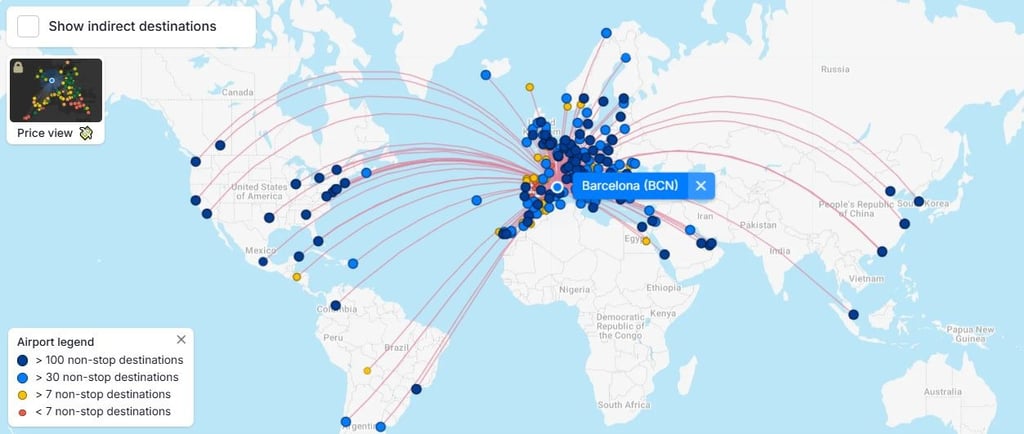

Map showing direct international flights to Barcelona on Flightconnections.com
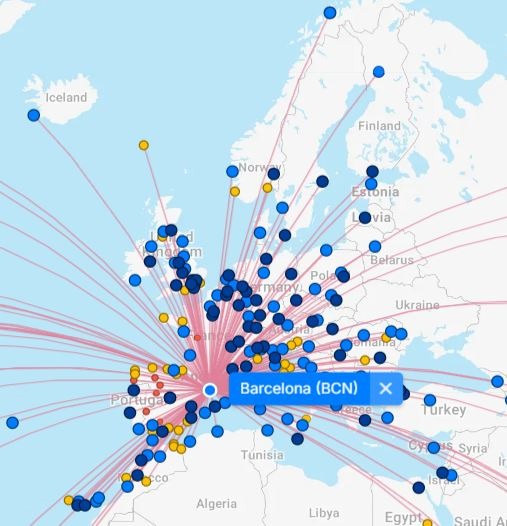

Direct Flights from Europe to Barcelona from Europe on Flightconnections.com
Once you are in Barcelona, you'll arrive at either Terminal 1 or Terminal 2 of El Prat airport. Be warned - it is an absolutely ENORMOUS airport and walking through it takes ages. To get to the city, you're really best using the train, which leaves from Terminal 2 only. There is a train that leaves every half an hour - when we were there, it was departing every 8 minutes past the hour and every 38 minutes past the hour. To get from Terminal 1 to Terminal 2, I understand there's a free shuttle bus (understandably) but we didn't use that, as we had the Barcelona Card that gives us free transport on all public transport in Barcelona, so we just jumped onto the Metro line that stops at both Terminal 1 and Terminal 2, got off at Terminal 2 and then walked to the airport train station. We 100% recommend the Barcelona Card to make your life easier, reasons given below.
Barcelona Card
Barcelona Card is the no. 1 Barcelona tourist card that includes 72h, 96h, or 120h worth of public transport, airport transport with either the train or metro to the city centre, along with free access to 28 of Barcelona's attractions. I had a bit of trouble finding out what exactly was included in this card and whether it would be worth our €50.30 EUR per person for the 72 hours card. The destinations and discounts on offer likely change every year, but I managed to find the 2025 PDF brochure, which you can have a look at by clicking here.
In our case, we knew we wanted to go to the MOCO Museum, Museo Picasso and the Banksy Museum at the very least, which would have cost us €45 EUR total per person in the first instance. The public transport and airport transport would have been an additional €25.50 per person and €4.20 EUR for the train each way between town and the airport, so that was already the equivalent of €79 EUR, so it was definitely worth it. Aside from just having everything in one place, it was so easy and we had no limitations on how much we could travel or where.
Some of the more attractive freebies or discounts that you get with the card, aside from public transport and airport transfers include:
Moco Museum (Free)
Banksy Museum (Free)
Picasso Museum (Free)
Castell de Montjulic (Free)
Montjulic Cable car (15% discount on return ticket)
Chocolate Museum (Free)
Casa Batlló (7 EUR discount)
Casa Amatller (20% discount)
Casa Mila - La Pedrera (1 EUR discount)
Casa Vicens (20% discount)
Casa Rocamora (20% discount)
Gaudi Crypt in Colonia Guell (20% discount)
Poble Espanyol de Barcelona (20% discount)
Gaudi Experience (20% discount)
Barcelona Casino (Free welcome drink)
You also get a map of the city as well as of the public transport, and a little guidebook for all the places that are included with the card.
The card can be booked online here and conveniently picked up at different parts of Barcelona El Prat airport:
Barcelona Airport, Terminal T1 Metro: from Monday to Sunday, from 8:30am to 2:30pm.
Barcelona Airport, Terminal T2 Metro: Barcelona Airport. From Monday to Sunday, 8:30am to 2:30pm.
Airport, Terminal T1: Barcelona Airport. From Monday to Sunday, 8:30am to 7:30pm - we got our card from here as we landed in Terminal 1. Just walk through customs and then on your right you should see the Tourist Information Centre for Barcelona, this is where you get your card.
Airport, Terminal T2: Barcelona Airport. From Monday to Sunday, 8:30am to 7:30pm.
Getting around Barcelona
The local public transport card is the T-mobilitat Transport Pass - The reviews for their app are incredibly poor so we decided against using that. Instead we used the Barcelona Card that gave us unlimited access to ALL the public transport for 72 hours and honestly, it was great and we can't recommend it enough. The best way to find your way through the city is to use Google Maps and tick the option for public transport, and it will tell you how to get from A to B. You can also click individual stations on the mobile app and it will show you all the routes on a map that you can take from that particular station (for example where you can go from the nearest station to your hotel) - it is a super handy feature! You also get a public transport map with your Barcelona Card, and these types of maps can be found in the metro stations too, as the one below.
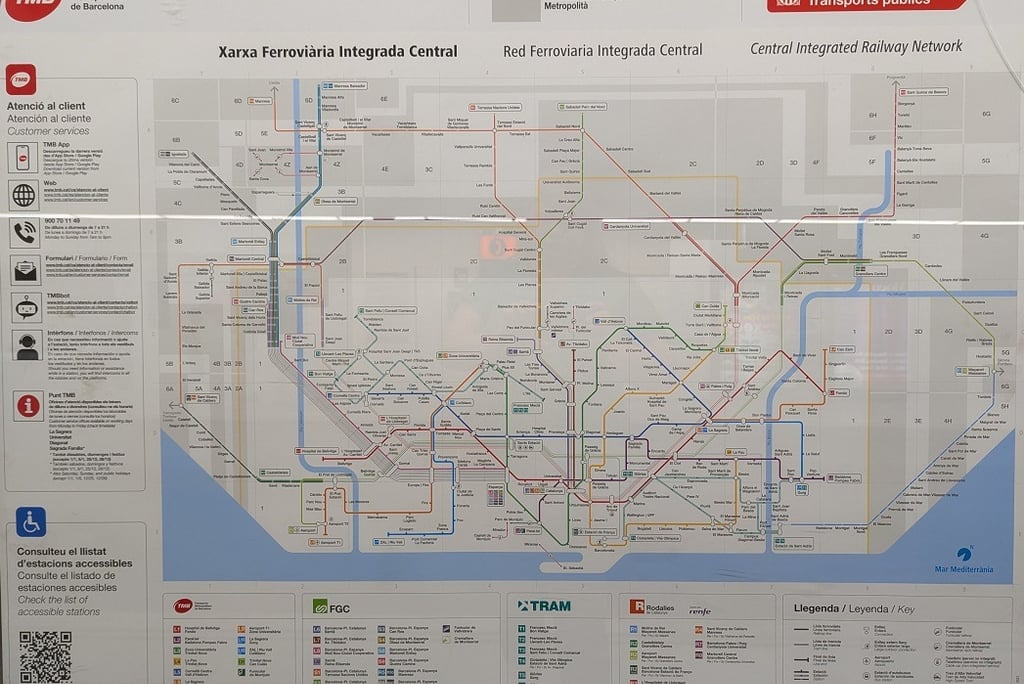

The public transport system in Barcelona
The Metro in Barcelona was our preferred method of travel, as it's fast, reliable, very frequent, well connected and well air-conditioned (at least the trains themselves). Just be sure to check the end stations at each end of the line you're travelling with so that you go in the correct direction. We also used the tram a couple of times between our station Selva de Mar and the Sagrada Familia, which was quite fun and you see a bit more of the city when above ground compared to underground. We didn't use any buses, but I imagine they must be decent, but trains / trams were our preferred method of travel.
If you need to get a taxi, for example to get home late when the public transport might feel a bit dodgy, the main taxi app used in Barcelona we found was not Uber, but rather an app called FreeNow, which works really, really well and we recommend using that in the first instance if you need a ride there and then. From my understanding, Uber is more of a pre-booked taxi sort of thing, where you'll need to wait at least 15 minutes for a driver to be assigned.
How to avoid the tourist traps in Barcelona
We were warned by just about everyone we spoke to about our trip to Barcelona about muggings, pick-pocketing and scamming of tourists. To be honest, we didn't meet any hustlers whatsoever while we were there - maybe it was because we were there in the shoulder season rather than high season? We also didn't stay out wandering around La Rambla at night, as our hotel was on the other side of town, but the one time we stayed out a little bit into the evening we could see things were starting to pick up with the hustlers annoying people in their seats at La Rambla restaurants.
The most notorious tourist trap area in Barcelona is La Rambla, which is described as "a world-class tourist trap with lousy food at inflated prices" and places very close to major tourist sites are also typically tourist traps. We didn't really spend much time at all at La Rambla, we found Passeig de Gracia much more charming, which is a street that starts just north of the end of La Rambla. The key is to venture beyond these obvious tourist zones to find more authentic experiences.
Warning Signs of Tourist Traps:
Restaurants with photo menus displayed outside
Staff aggressively trying to lure you inside
Menus translated into multiple languages with no local language versions
Locations directly on major tourist streets
La Rambla is not the best place to eat and drink as the high foot traffic means many tacky restaurants rely on undiscerning tourists and are not incentivised to provide great food. You honestly don't have to venture far away to find something much better, literally maybe just a block or two, as we found out.
How to Find Authentic Food Experiences
Look for Local Indicators:
Venture into neighborhoods like Gràcia, Sant Antoni or Poble Sec for authentic dining
Restaurants whose menus are only in Catalan or Spanish, often displayed in chalk or printed wall signs
Establishments that follow Spanish dining customs - lunch around 2 p.m. and dinner after 8 p.m., meaning any restaurant opening earlier is likely targeting tourists
Places filled with locals rather than tourists - choose establishments where you hear locals speaking Catalan or Spanish
Restaurants in residential neighborhoods away from main attractions
Avoid any place with photos of food posted outside
Places to stay in Barcelona
Different Neighbourhoods of Barcelona
Barri Gòtic (Gothic Quarter)
Very central: medieval streets, charming plazas, historic sights everywhere. Great atmosphere for first-timers or people who want to soak up the old-city feel.
Very touristy, especially during daytime. Narrow winding streets mean noise, especially at night. Pickpockets are more common. Accommodations aren’t always quiet or modern.
Ideas of places to stay in the Gothic Quarter:
H10 Madison 4* Sup: Smack in the middle of the action, with utterly stunning views over the cathedral, sun loungers and pool on the terrace. Fairly pricy though at around £300 GBP per night in autum.
Uma Suites Pau Claris: Nine enough double rooms and among the cheapest you can get that is pretty good quality, with prices hovering around £200 GBP per night in autum.
Aparthotel Arai 4* Superior: Beautiful gothic style hotel with a rooftop pool. Prices around £280 GPB per night in autumn.
Eixample
More spacious, elegant streets; nice mix of modern and old. Good for architecture lovers (Gaudí’s works like Casa Batlló, Sagrada Família), shopping (Passeig de Gràcia), more comfort. Safer, more “upmarket.”
More expensive. Because of its size, some parts are further from key tourist spots or beaches so you’ll rely on public transport more. Less “medieval charm” or the winding-streets character.
Ideas of places to stay in Eixample:
H10 Casa Mimosa 4* Sup: Beautiful hotel with beautiful gardens and roof terrace with a pool and seading overlooking Gaudi's La Pedrera - Casa Mila. Price around £300 per night in autum, which for the location seems like a bargain compared to the Gothic Quarter.
Seventy Barcelona: Industrial-looking hotel, very modern and sleek. Nice looking garden seating and roof terrace with book and sun loungers. Price around £240 GBP per night in autum.
ZOOROOMS Boutique Guesthouse: A lot more basic but appears perfectly functional. Looks like it would cater to younger people, with access to kitchen area for cooking, hammocks etc. Rooms with a terrace are around £120 GBP per night, which is a fraction of most other places.
El Born
Trendy, stylish, full of good restaurants, boutiques, galleries. Close to cultural spots (Picasso Museum, etc.), reasonably central. More “local” feel than Gothic Quarter in many parts.
Can get crowded and noisy, especially near main tourist-routes. Fewer big open spaces; sometimes lodging is in older buildings with less insulation or modernity. Also at night the atmosphere can get busy. Reviews of hotels in this area are typically not great.
Ideas of places to stay in El Born:
En Casa de Calders 5: Looks like a really nice wee flat smack in the middle of things, with the Moco Museum practically on your doorstep. Prices are around £200 GBP per night in autum.
Musik Boutique Hotel: Looks quaint and building traditional. It is popular and highly rated. Price was around £150 GBP per night in autumn.
Best House Best Place: This place seems to live up to its name as it gets an average rating of 9.4 on Booking.com. It's just a fairly basic small flat though, but in the middle of the action. Looks very much like a batchelor's pad, right next to Basilica de Santa Maria del Mar.
Gràcia
Great if you want something more local, laid-back, artsy. Nice plazas, cafés, small-scale boutiques; good for a slower pace. More residential, so less hustle and bustle.
Might feel a little far from some major tourist landmarks; some parts require transit to get to things. Fewer large hotels, sometimes more boutique or apartment-style stay options. Less nightlife (depending on what you want) in certain parts.
Ideas of places to stay in Gràcia:
Hotel Casa Fuster G.L. Monumento: Looks a bit dated but nice enough in a classical hotel costing around £300 GBP per night in the autum.
El Patio de Gracia: Three-bedroom quaint little apartments. The price seems to suggest they will charge you as much for 2 nights as for 1 night. Based on 3 nights, the price was about £250 GBP per night.
Barceloneta
Excellent if you want the beach. Very close to the sea, lots of seafood restaurants, promenades. Nice for mixing sightseeing + beach time.
Very crowded in summer; beaches and the nearby areas get busy. Tourist price hikes in restaurants & lodgings. Nights can be noisy. Also lodging tends to be more basic or small in size, since many buildings are older.
Ideas of places to stay in Barceloneta:
Lodging Apartments Barceloneta Beach Studio 42: Nice looking one-bedroom apartments where you can self-cater, which is what we typically like, especially when staying somewhere for a bit longer. The rate was around £200 per night when we were in Barcelona.
Barcelona Beach Apartments: Small flats but right on the beach (as the name suggests), many which include a balcony. Prices were about £150 per night, but obviously depends massively on the season.
El Raval
Very multicultural; vibrant arts / alternative scene (museums, cultural centres, cafés). Budget-friendlier in some parts. Good for adventurous travellers who don’t mind a bit of grit.
Safety is more of a concern in El Raval, especially at night. Some areas feel rough; issues with petty crime / pickpocketing more frequent. Noise, less polished infrastructure in parts. Could be too lively/noisy if you want rest.
Ideas of places to stay in El Raval:
Barceló Raval: Modern hotel with a rooftop terrace / pool with 360 degree views of Barcelona. We considered staying here before we read about the safety issue in El Raval. Hotel looks great and many, many people stay here. The price per night in the autumn was around £150 per night.
Central Apartment: Very spacious and great value for money It sleeps up to 6 people in a 2-bedroom apartment with all the modern amenities, at a price of just £150 per night.
Poblenou
More relaxed, especially compared to the very central tourist zones; good for digital nomads, people who like trendy cafes, something modern but less crowded. Close to beaches. Often more affordable.
Less “historical charm” if that’s important; may require more transit time to some landmarks. Fewer large hotels; evening options may be more subdued compared to Gothic or El Born. Some areas still developing, so amenities vary.
Ideas of places to stay in Poblenou:
The Level at Melia Barcelona Sky: Very modern hotel with amazing views over the sity and a sizeable pool and lounge area. The price per night is a bit high at £220 in the autumn, but that's what some people are willing to pay! It's also just a 3 min walk to the Pere IV tram station which will take you to Sagrada Familia in 8 minutes.
Ibis Barcelona Plaza Glories 22@: We've always gound the Ibis to be a reliable hotel brand if you want modern creature comforts for not too much money. Cheap and cheerful, the price for the night in autumn was about £140 GBP including breakfast.
Sarrià-Sant Gervasi
Very residential and upscale, quiet, green, safe. Good if you want peace, perhaps travelling with family or just want to escape tourist buzz. Nice architecture and comfort.
Farther away from lots of main tourist sites; more commuting if you want to visit many sights. Fewer restaurants/tourist-style nightlife in walking distance. More expensive. Some transport may require connections, though the L7 metro line will get you to Plaça de Catalunya in just 9 minutes (5 stops).
To give you a rough idea of where the above neighbourhoods are relative to each other, see the schematic below.
Ideas of places to stay in Sarrià-Sant Gervasi
Vilana Hotel Boutique: Looks quaint and cozy, with rooms at around £160 per night in autumn.
Bonanova Suite: Get lots for your money - a suite with lots of space and a kitchenette for just £130 GBP per night.
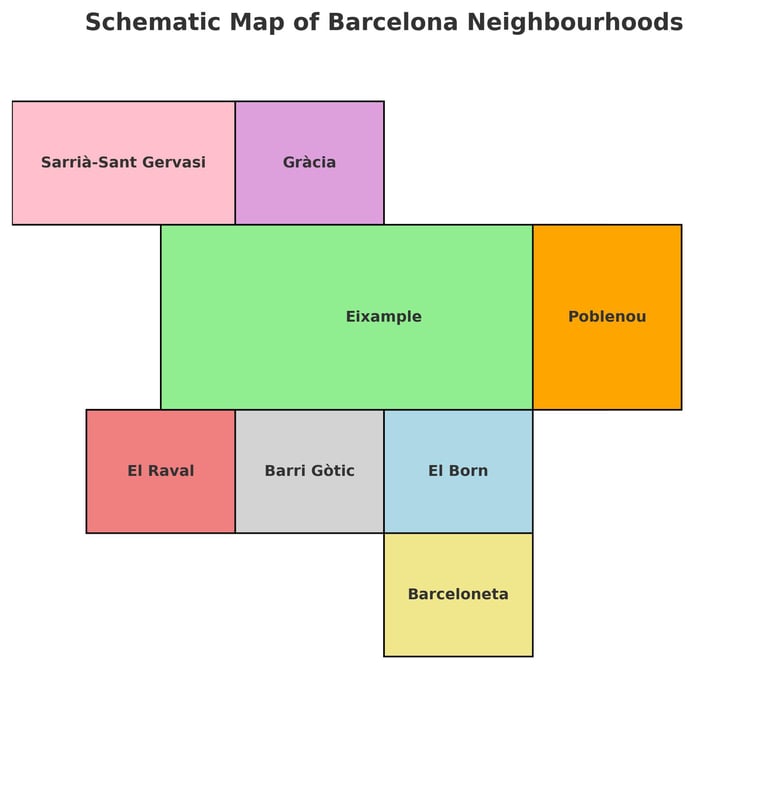

During our research for places to stay in Barcelona we found that each of the different neighbourhoods have wildly different character and price categories. So before suggesting any specific hotels, it's worth looking at the different neighbourhoods and what you might actually be looking for.
[BACK TO TABLE OF CONTENTS]
Places to eat in Barcelona
First thing's first - as people who know us know, we love a bargain! And we LOOOOOOOVE eating tasty food. Therefore, I want to recommend a great app to you which is absolutely excellent for foodies who love a bargain!
TheFork app
This app is great. It is used by the Michelin Guide, but it allows you to:
book tables at restaurants worldwide, including Barcelona. Many of the restaurants you'd want to go to are there already, but rather than just walking in or booking through their website,
You earn credits on the app, to be used in restaurants all over the world - what's not to like!!
Many of the restaurants offer special discounts to those that book through the app, often between 30-50% off your bill! I know all this because when I was researching for, and drafting this section on Places to Eat in Barcelona, I first wrote up the restaurants I fancied going to, but then I remembered the app and thought I'd cross-check all these places on the app and found that many of them had either special offers, or the potential for collecting points for going there.
So that's a 100% win-win-win all over! Imagine the smile on the face of the bargain rat that is me!
And what's even better is that if you use a referral code when you book a table anywhere in the world on TheFork app for the (take note of the referral code: 85732A3C), you get 1000 "Yums" (reward points) when you use the code on your first booking, PLUS any Yums you get for the booking itself, which depends on how much you end up spending. Get the App here on Google Play, or here on Apple App Store.
1000 Yums = €10 EUR off at participating restaurants in Spain (at the time of writing), but in the UK, 1000 Yums = £20 GBP. The monetary reward (in form of discounts) varies a bit across countries.
Where we wanted to eat
I already touched on things to avoid in an earlier section on common scams and tourist traps in Barcelona. When it comes to places to eat, there's only so much one can eat when you only stay in the city for 72 hours! However, below are some of the places we considered going to, and some of the places we did end up going to and whether we recommend them or not.
On of the great things about going to such an important and popular Spanish city is the fact that a lot of people from the Spanish-speaking Latin American countries have moved here, many of which have started their own businesses, such as restaurants representing their home countries. I miss Latin American food so much, it's super rare to come across in the UK, as the immigrant cuisine in the UK is largely made up of Indian curry houses and Chinese take-aways (though obviously there are others, they are just harder to find). This is why I went through particular effort in trying to find Latin American cuisine in Barcelona, because Spanish food is generally easy to come by both where we live in Glasgow, but also where Joe's mum lives in the Torrevieja area of Valencia (in fact we had just come from a Costa Brava tapas-eating challenge before going to Barcelona - see our video blog from the Benijofar Costa Brava Tapas Train challenge on YouTube here!).
The saddest thing was that we were only staying for two full days in Barcelona, leaving us with maximum 5 possible meal times, so choosing between the below restaurants was REALLY HARD. Plus, one of our meals was "out of action", as we had a dining credit to use from our Platinum American Express card, leaving us with just 4 meals to really choose from.
Chilean Restaurants in Barcelona
I have spent so much time in Chile and love Chilean food. People might disagree with me - Chilean food is in many ways quite similar to British food, which by many is considered "bland" but I disagree. I love British food. But also, while Chilean food sure does have some similarities, they also do their own twist on the food, which in my opinion just makes it that much better! The Chileans do these pies, like Pastel de Papas, which is very similar to the British Cottage Pie, except they add a few raisins into the mince that gives it a bit of sweetness, as well as slice of hard-boiled eggs. They also do another pie called Pastel de Choclo which doesn't really have a British equivalent - a mince topped with ground corn and topped with sugar, super tasty. They also do Empanadas which are like Cornish pastries, but again with their own twist on it - the most popular ones being Empanada de pino al horno (oven baked filled with mince, scarce raisins and hard boiled egg), empanada de marisco (typically deep-fried with shrimp/prawn and cheese) and empanada de queso (cheese filled and deep-fried). The Chilean sandwiches are famous as well, usually containing loads of thinly sliced meat, mashed avocado, meaty juicy tomatoes and mayonnaise (usually "Italiano" style sandwiches, like Churrasco Italiano), but some that contain loooooooooads of melted cheese and meat like the Barros Luco sandwich. The Chilean hot dog is also very famous, typically served in a large hot dog bun with the sausage at the bottom, then filled with mashed avocado and finely chopped tomatoes, topped with home-made mayonnaise. Yum. Then there are other things that I love, like the Cazuela meat soups, the Bistec a lo pobre steaks with fried egg on the side, as well as Chorillana, a popular and indulgent Chilean dish consisting of a bed of crispy french fries topped with various ingredients like caramelised onions, sliced meat (often beef), sausages, and eggs (fried or scrambled). Then, not to mention all the delicious grilled meats and sausages they do in Chile, as well as abundance of seafood, such as ceviche.
Torres del Paine Restaurant in El Raval. Serves empanadas, pastel de choclo, pastel de papas, chupe de mariscos, chorillana, ceviche, parmesan oysters, grilled meats, sopaipillas, pie de limon and more.
El Vuit Gastronòmic in Sant Antoni. Serves Chilean hotdogs, chorillanas, Chilean style salads, pastel de choclo, pastel de papa, ceviche, chupe de mariscos, machas a la parmesana, cazuela, langostino al pil pil, empanadas, churrasco sandwiches, barros lucos sandwiches, barros jarpa, lomito italiano and so on. All the CLASSICS! Also serves typical Chilean cocktails, like Pisco Sour, Piscola and Terremoto!
Perro Pako Bar in El Raval. Very basic bar type of place but serves some of the classica like Empanadas, Chilean hot dogs, sopaipillas, pastel de choclo and pebre. They also (obviously) do piscolas, as well as Terremoto and pisco sour cocktails.
Peruvian Restaurants in Barcelona
Peru has one of the tastiest cuisine in the whole world, largely thanks to its incredible variety of potatoes and the ají amarillo they use in so many delicious dishes. Those include Papa a la Huancaína (boiled potatoes topped with a creamy cheese sauce made from ají amarillo, queso fresco, milk, and crackers), Causa Limeña (layered mashed yellow potatoes seasoned with ají amarillo, lime, and oil, often filled with chicken, tuna, or seafood), Ají de Gallina (shredded chicken in a rich, creamy ají amarillo sauce thickened with bread, nuts, and cheese), Seco de Cabrito (or Seco de Res) (A cilantro-based stew. usually goat or beef, that often includes ají amarillo in the seasoning base), Pollo a la Brasa with ají amarillo sauce (the famous rotisserie chicken is usually served with dipping sauces, the most beloved being ají amarillo cream) and many more.
Pueblo Libre in Sant Antoni. Serve things like Lomo Saltado, Aji de gallina, Arroz con pato y salsa huancaina, ceviche, aji de gallina croquettes, Causa limeña, Yucas fritas a la huancaina and papa a la huancaina, along with other classics.
La Cevicheria in Sant Marti. Serve mostly just seafood and ceviche, Peruvian style.
Barrio Santo in the Gothic quarter. Serve Peruvian classics like ceviche, ahi de gallina, lomo saltado, causa, tamales, papas or tallarines a la huancaina, tacu tacu and more. The restaurant is on TheFork app, which will give you 30% off the food on most days.
Cumpanama near Sagrada Familia. Serve all the classics, but also do an excellent two course lunchtime offer with a drink for €15.90.
Nazca - Brunch Peruano in Eixample area. More quick bruch type of place serving things like tamales and Peruvian style sandwiches.
Yakumanka by Gastón Acurio in L'Eixample. Serves Causa Limeña, Empanadas, Ceviches, Lomosaltado, Ají de Gallina and more. Fairly upmarket and so, a bit on the more expensive side, as it's a Gastón Acurio restaurant (very famous Peruvian chef). Bookable on TheFork, if you have credit to spend.
Mexican Restaurants in Barcelona
I've been to Mexico twice - the first time I went with a friend of mines to Mexico City and Michoacan state, where I got introduced to fantastic authentic Mexican food like mole and Al Pastor, among many other delicious things. The second time I went with Joe to the Yucatan Peninsula where we travelled through the states of Quintana Roo and Yucatan and got to know some of the incredible cuisine from that area, like Cochinita Pibil and Huevos Motuleños. The breakfasts we had in the Yucatan peninsula were generally INCREDIBLE and we go and search for Mexican breakfasts whenever we can. It's actually worth booking a hotel without breakfast if you have a Mexican restaurant near your hotel selling breakfast. Oh my goodness yummy.
La Güerita Mexicana in Sant Antoni. Serves El Pastor, Poblano, cochinita pibil and birria style meats in form of tortas and tacos, chilaquiles
La Pachuca in the old town. Serve carnitas, mole, cochinita pibil, enchiladas. They also deliver with Uber Eats.
Chilango's in El Raval. Serve burritos, enchiladas, tacos like Al Pastor, Birria and Cochinita, flautas, nachos. Bookable on TheFork, if you have credit to spend.
Tlaxcal Cantina &Taqueria Gastronomica in El Born. They do Barbacoa, Al Pastor, Gringa, Cochinita pibil style and fish tacos, etc. Bookable on TheFork, if you have credit to spend.
Argentinian Restaurants in Barcelona
I used to live in a small village in La Rioja province called Villa Union. I have also travelled far and wide across this vast country and enjoyed its cuisine. Obviously, grilled meat is up there with the most amazing Argentinian dishes but they also do some interesting dishes that are versions of Italian originals, with their own spin on it. Argentinian pizzas for example are a bit weird, but also weirdly delicious. The bread almost has the texture of a Foccacia, completely covered by melted cheese. Likewise, they also do this dish called Pollo a la Milanesa which I found delicious and not found it anywhere else outside Argentinian cuisine, a schnitzel type of chicken that's breaded and topped with tomato, ham and mozzarella cheese and is delicious. They're obviously also huge on things like dulce de leche (Argentinian caramel).
Retruco in Sant Marti. Serve Milanesa de Pollo, Lomito, Morcilla sausage (blood sausage) with chimichurri, Argentinian style pizza, meats and more.
Don Asador in L'Eixample. Serves MEAT and a lot of it! Bookable on TheFork, where you get 30% off on most days when a table is booked through the app.
Braseria Barcelona in L'Eixample. Same as Don Asador. Bookable on TheFork, where you get 50% off on most days when a table is booked through the app.
Grill Argento in the old town. Also serve lots of meats, but also empanadas and sandwiches. Bookable on TheFork, where you get 40% off on most days when a table is booked through the app.
Venezuelan / Colombian Restaurants in Barcelona
I group these two together, because the typical dishes of these countries have a lot of similarities. The most stereo-typical food you get (and love) in these countries include the Arepas - corn flatbreads filled with all sorts of different fillings. Both countries are also huge on corn-based Empanadas, but personally I am not too much of a fan of those, as I just feel like the texture is wrong (sorry if I offend anyone). I prefer the Argentinian / Chilean style of empanadas myself. However, if you are like me and have serious cravings for Arepas (because of the very few restaurants that serve them in Glasgow, they are always completely rammed full and I'm yet to manage to get a seat!), there are a few options in Barcelona:
Restaurant Cantero in Sant Marti. Does Arepas filled with Reina Pepiada, Llanera, Carne Mechada, Pollo, Pabellon etc.
Tumatey in Eixample. Does Arepas filled with Llanera, Domino, Villa, Reina Pepiada, Canaima, Gran Sabana, Pabellon and more.
Tu Cachapa in L'Eixample. Does Arepas filled with Sifrina, Mona, Pelua, Rumbera, Catira, Huevoperico and Pabellon.
Decisions, decisions!
Now.... that's a lot of choice for just 4 meals, and all sounded equally delicious so we had to strategise. What were the MUST-HAVES while in Barcelona? That is, something that is very difficult to get back home. The clear winner was Chilean food, for sure, because I absolutely love Chile and I miss the country, the people, the drinks and the cuisine so much! A second consideration was distance to the restaurants from where we were at any given day.
[BACK TO TABLE OF CONTENTS]
Our Recommendations of Places to eat in Barcelona
Below are the places we actually ended up going to from the list, but also other places we found ourselves when we needed a snack. These include Argentinian-style steakhouse, a Chilean restaurant, a Peruvian restaurant and a microbrewery pub with excellent snacks!
LomoAlto near Passeig de Graciá - Argentinian style steakhouse
While not strictly classed as an "Argentinian steakhouse", it definitely is an Argentinian-style steakhouse and as you walk in you see all these amazing cuts of meat. This place is for carnivores! We went there on the evening we arrived in Barcelona.
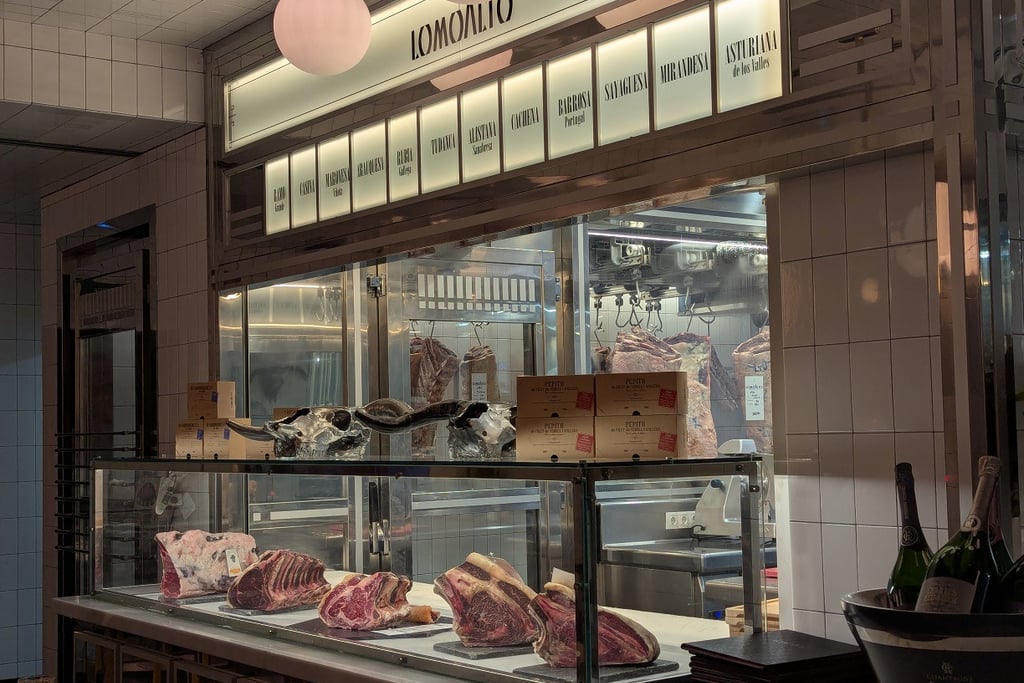

Some of The Cuts of meat on offer at Lomo Alto Steakhouse
This place may not be within everybody's budget - it certainly isn't within our usual budget, but we were lucky enough to have an American Express Dining Abroad £100 GBP credit to spend before the end of the year, so this was the perfect opportunity for us.
We were sat down in this cozy upstairs room with absolutely enormous tables. Joe thought we might need to shout to hear each other, but luckily the restaurant isn't noisy (or at least when we were there).

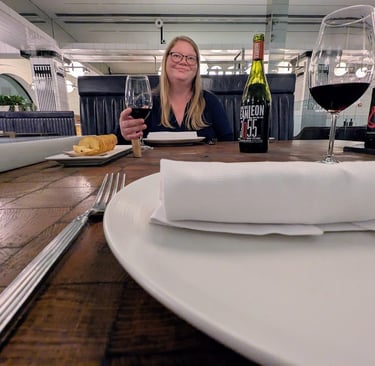
Me and Joe were sat miles apart at the huge tables at Lomo Alto
After a short skim over the menu we knew what we fancied - something we had never tried before, as it's usually a bit out of our price range. We ordered ourselves a 1kg T-bone steak with a sort of a cheese potato puree and chips for €80 EUR, along with a bottle of wine but also some iberian ham croquettes for starters. The bill came to a total of £123 GBP, of which American Express paid £100 GBP. So we had this feast for just £23 - bonkers! And awesome! If you want to learn how to get this offer, along with many other awesome perks, check out our Avios Tips & Tricks page.

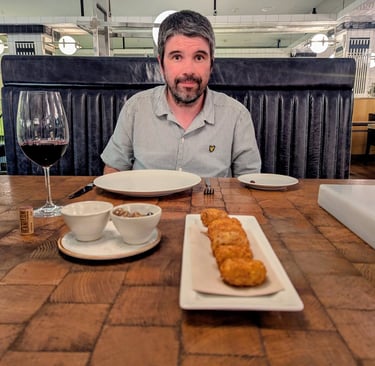
Iberian Ham croquettes at Lomo Alto Steakhouse
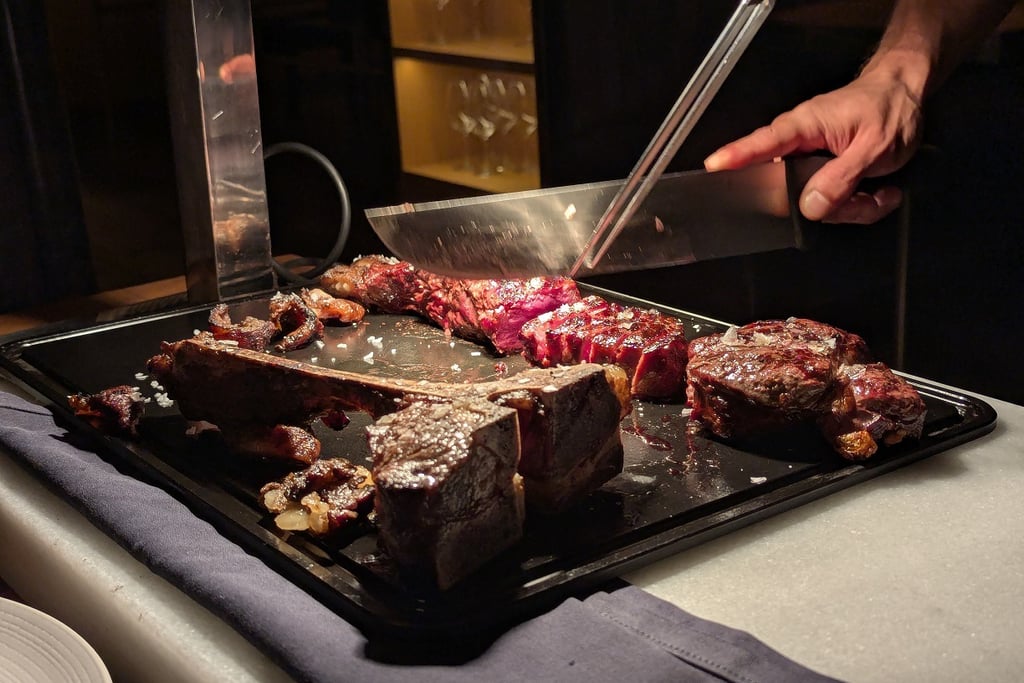

The Waiter cutting up our T-Bone STeak at Lomo Alto
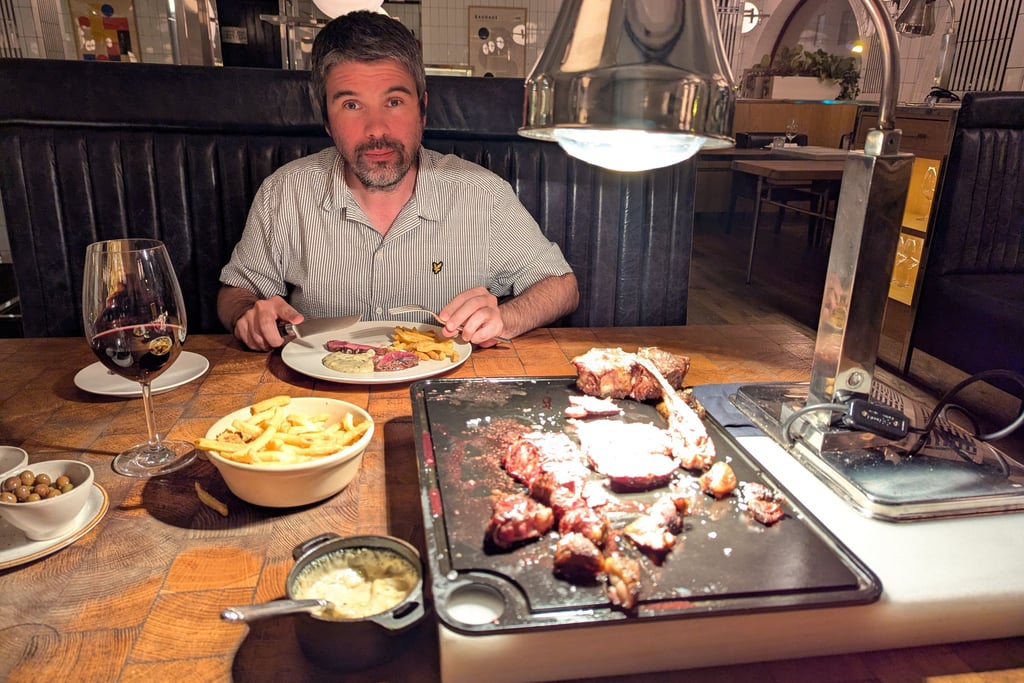

Joe a happy boy with T-bone steak and chips!
So what's the verdict for LomoAlto steakhouse near Passeig de Graciá station? Answer: ⭐⭐⭐⭐⭐
We absolutely LOVE it! It was probably the best steak we ever had (or certainly gave some of the best ones run for their money!!). Absolutely delicious and everything was perfectly done. The slicing of the steak for us with a huge machete-type of knive was also a nice wee theatre that was fun. The staff was very attentive and we really enjoyed the experience - if we were back in Barcelona, we'd go with or without dining credit, cause we just want this! Yum.
See the restaurant on Google Maps here.
[BACK TO TABLE OF CONTENTS]
El Vuit Gastronòmic - Authentic Chilean Restaurant outside Urgell Metro Station (L1 Line)
This place was on my MUST-GO places, so besides using our Amex dining credit at LomoAlto, this was the next place we (in my opinion) NEEDED to tick off the list before anywhere else. The restaurant serves all the Chilean classics - hotdogs, chorillanas, Chilean style salads, pastel de choclo, pastel de papa, ceviche, chupe de mariscos, machas a la parmesana, cazuela, langostino al pil pil, empanadas, churrasco sandwiches, barros lucos sandwiches, barros jarpa, lomito italiano and so on.
They also serve typical Chilean cocktails, like Pisco Sour, Piscola and Terremoto, but what I really drew me in was the fact that they sell our favourite Chilean beer - the Calafate beer from the Austral brewery. We have so many nice memories from our South of Chile adventures drinking that beer.


CaLAFATE Beer from the Chilean Austral brewery at El Vuit
The toughest part, honestly, was choosing what to eat, because we were likely only going to get to come here this one time. I love traditional Chilean food and it had been years I had it. Even when we were in Chile several years ago now, with capitalism running everything in Chile these days with chain restaurants churning out mass produced poor quality grub in so many places, it has become really hard to find authentic Chilean food in Chile (if you are based in Chile and know of great authentic restaurants, especially in the central region including Santiago / Viña del Mar / Valparaiso / La Serena, please let us know!!). So this place is like heaven for me!
After much thought, and trying to strategise how to fit as much food in as possible, I decided to order us four different things to share:
Empanada de Pino: An oven-baked empanada filled with beef, onion, gravy, slice or two of a hard boiled egg, couple of olives and couple of raisins. Their empanada de pino tasted 100% authentic and took me straight back to Chile 20 years ago! Awesome. ⭐⭐⭐⭐⭐
Empanada de Camarón & Queso: Deep-fried empanada filled with melted cheese and prawns. Same as the Empanada de Pino, 100% authentic and awesome. Cheese and prawns go soooo well together. ⭐⭐⭐⭐⭐
Pastel de Choclo: A traditional Chilean dish, a savory and sweet corn pie similar to a shepherd's pie with a savory filling of ground beef, olives and raisins, which is then covered with a thick layer of sweet corn purée and baked until golden. The sweet and salty flavor combination is enhanced by the caramelised sugar sprinkled on top before baking. The pastel de choclo was served in a traditional Chilean clay dish with all of the typical ingredients. Awesome!⭐⭐⭐⭐⭐
Barros Luco: A classic Chilean hot sandwich made with grilled steak and melted cheese. I love this sandwich but in this particular case I felt like the, meat, albeit plentiful, as was the cheese, it was missing a touch of seasoning ⭐⭐⭐⭐
What we got as well, which I found an INCREDIBLE bonus, was an authentic Chilean Pebre ⭐⭐⭐⭐⭐ with crusty bread as a free appetizer. O-M-G... This pebre is perfect!! So fresh and took me right back to Chile. For those who don't know what the Pebre is, it's sort of similar to the Mexican pico de gallo. However, it is more herbaceous, garlicky and tangy with the flavour of the cilantro and chili dominating rather than tomato, which is much more finely chopped and more "saucy" than pico de gallo; often more like a super fresh tasting relish. It is served as a condiment for asados (barbecues), bread or empanadas. It’s an essential table condiment in Chile, like salsa or chimichurri elsewhere and it is bloody delicious!!!!
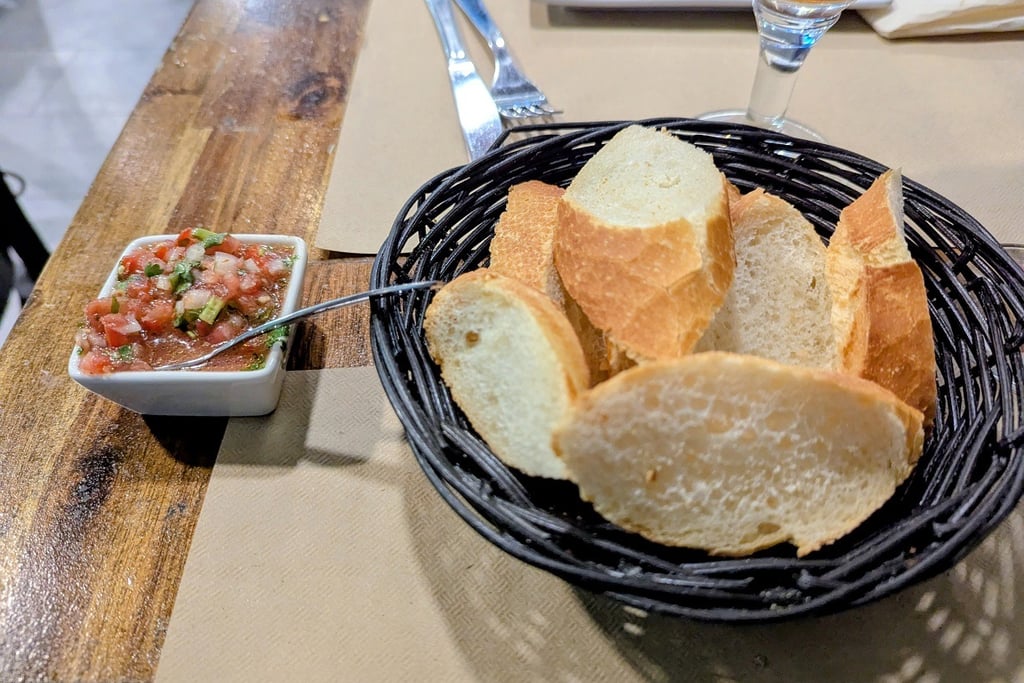

That Chilean Pebre on the left is an fresh flavour bomb!! Especially if you like cilantro.
The appetizer was a bit too good, because we needed to save space for the starters and mains but I just wanted to devour the lot!
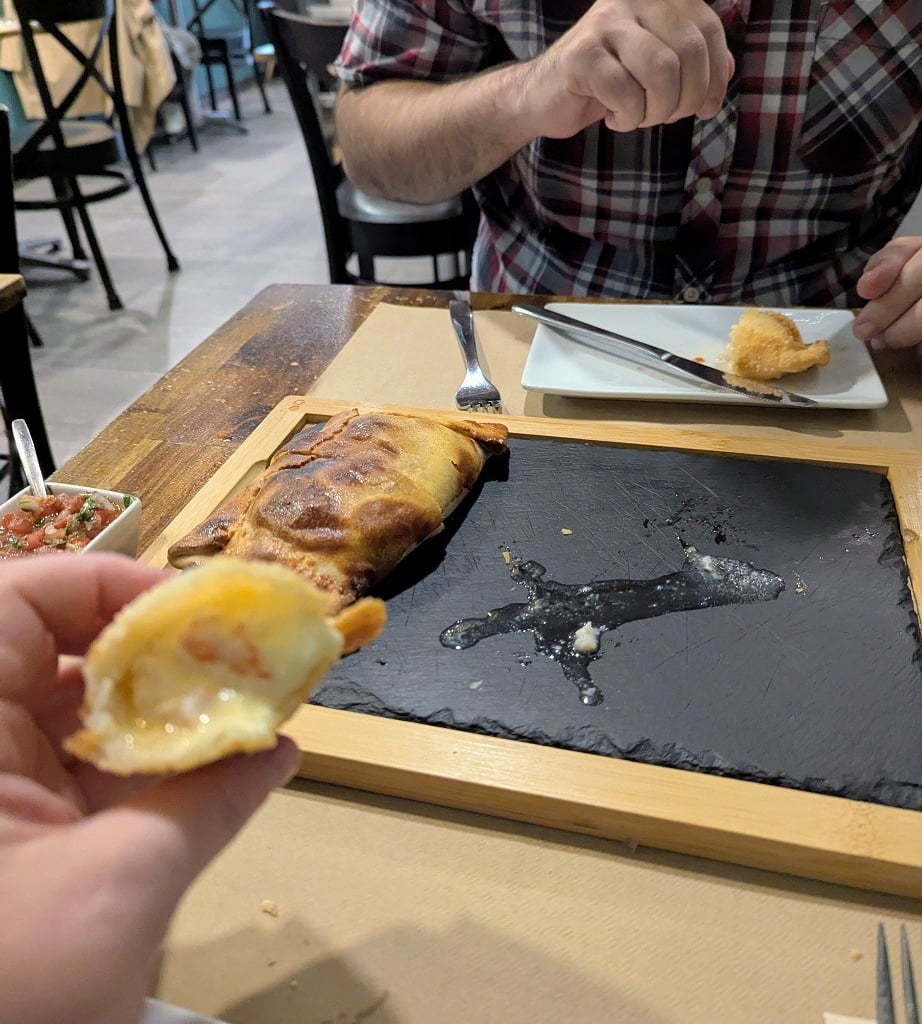
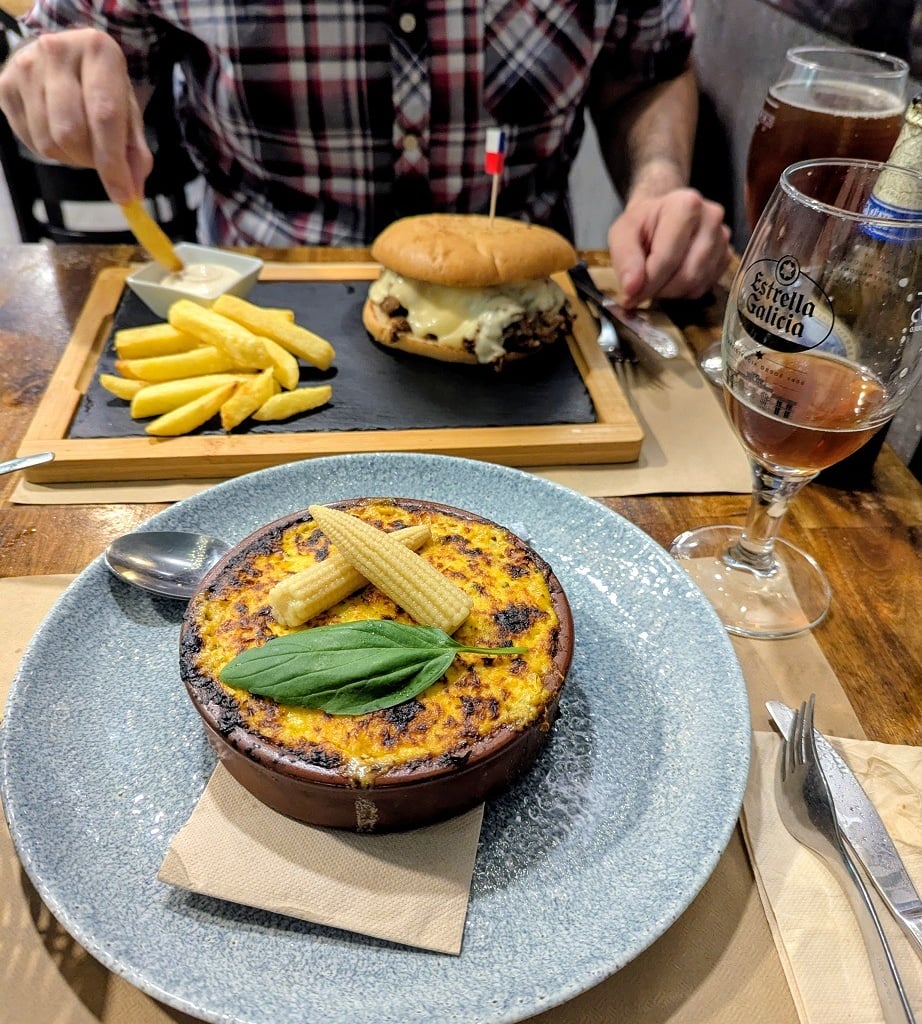
Empanadas for starters, Pastel de choclo and Barros Luco sandwich for mains
So what's the verdict for El Vuit Gastronòmic Chilean restaurant near the Urgell metro station? Answer: ⭐⭐⭐⭐⭐
I was soooo happy to come here, meet the owner who is from Viña del Mar and finally get to eat some delicious Chilean food! For me it is incredibly nostalgic, as I have lived in Chile and have super fond memories from there. If you have connections to Chile and like Chilean food, this is totally the place for you! It is perfect!
See the restaurant on Google Maps here.
[BACK TO TABLE OF CONTENTS]
Sukhu 111 - Spanish tapas restaurant near Selva de Mar metro and tram station
This is where we ended up in the evening after having lunch at El Vuit. We had grand plans of eating our way through as many restaurants as possible, trying lots of Latin American food, however the food at the Chilean restaurant was so hearty, filling and loads of it, that we couldn't imagine ourselves going out for a proper meal for dinner. Therefore, at 9pm we found ourselves at the local tapas restaurant on the same block as the Melia we were staying at near Selva de Mar metro station. I didn't take any pictures, just because we didn't order anything fancy or interesting, we just needed a wee snack of some ham croquettes and patatas bravas at the end of the night with some wine or sangria. We liked it enough to come back the next night for exactly the same - a wee snack at the end of the night, and it was perfect for that.
So what's the verdict for Sukhu 111 - Spanish tapas restaurant near Selva de Mar metro and tram station? Answer: ⭐⭐⭐
It is fine, and it was perfect for what we needed - somewhere close to our hotel for a quick bite to eat. But the restaurant isn't particularly cheap (nor particularly expensive) and the patatas bravas and croquettes were quite typical for anywhere in Spain. The staff though are super friendly and they really make the place. However, I also feel like I can't really rate this restaurant properly, cause we didn't really taste their main dishes or any variety of their tapas, we just went for the "same old". It gets really good reviews on Google, for their paella among other things.
See the restaurant on Google Maps here.
[BACK TO TABLE OF CONTENTS]
Campanamá - A Peruvian restaurant near Sagrada Familia
I had originally booked us into this place for a late dinner on the same day as we went to the Chilean restaurant, but we were still so full in the late afternoon that we knew we'd just not enjoy eating. We'd be force-feeding ourselves, so I cancelled the booking and booked us in for the following day. Campanamá is one of the restaurants in Barcelona that accepts Yums reward points from TheFork app as currency, the place is also reasonably priced, gets good reviews and has all the Peruvian classics. I had €25 EUR worth of free dining credit to spend on my TheFork app (you can also get free dining credit by simply signing up and booking a table at a restaurant, see above). However, there are only limited time slots where you can claim your Yums and the last one available for that day was at 16:30, but that was OK, as we had had a lovely snack earlier at CocoVail to keep us going until then.
We managed to get a seat outside, and noticed by chance they were still serving the day's lunch offer:

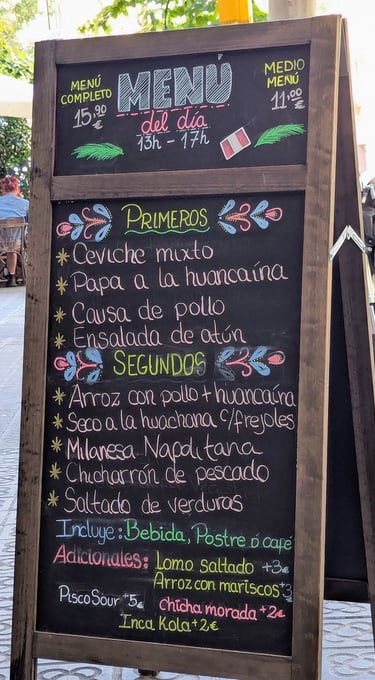
Lunch menu of the day at Campanamá
That was a great deal at €15.90 per person including a starter, main and an alcoholic or non-alcoholic drink - even better when you have a €25 EUR dining credit to spend!
Some of the highlights on that menu on that day for both of us was the Causa,but I was also tempted by the ceviche and the Papa a la huancaina. Huancaina is a famous Peruvian sauce - creamy, mildly spicy and flavorful, made primarily from ají amarillo (Peruvian yellow chili pepper). But what I really wanted was the Causa - it isone of Peru’s most iconic and beloved cold dishes, typically consisting of a layered potato terrine type of thing, made with yellow potatoes, lime, ají amarillo (yellow chili pepper) and oil, typically filled with tuna, chicken, seafood or vegetables, and served cold. However, our one was a rolled chicken causa rather than a layered one. It was super tasty and fresh, though I do think they could have oomph'ed it a touch more with the yellow chilli, but that's just a personal preference.


Causa de Pollo at Cumpanama Peruvian Restaurant near Familia Sagrada in Barcelona
For the mains, we decided to mix it up and get two different dishes from the menu of the day: Arroz con pollo & huancaina (chicken with rice and huancaina sauce) and the legendary Peruvian stir-fry dish Lomo Saltado, which is stir fried beef with onions, tomatoes, tasty sauce and chips. Both were delicious!


Pollo con arroz & Huancaina (right) and Lomo Saltado (left) at the Cumpanama restaurant
So what's the verdict for Cumpanamá Peruvian restaurant near Sagrada Familia station? Answer: ⭐⭐⭐⭐
I cannot possibly argue with the quality of service, food, drink or price. I mean, we only ended up paying €9 EUR, thanks to my TheFork dining credit, but even without it the price is very fair and the food is very tasty and beautifully presented. My only downgrade is that the Huancaina sauce just needs a bit more kick up the arse in terms of heat. Not too much, but just enough so that you can actually taste the beautiful aji amarillo, especially as it forms such an integral part of Peruvian cuisine. I guess they may have toned it down for the Spanish? As they're not big on spicy food in general. However, highly recommend this restaurant.
See the restaurant on Google Maps here.
[BACK TO TABLE OF CONTENTS]
CocoVail Beer Hall - An American style craftbeer pub near Passeig de Graciá
We had booked a table at a Peruvian restaurant for a very late lunch / early dinner at 16:30 (reasons to be explained later), so we knew we'd need something to tide us over or else we'd be starving and "Hangry" by the time we'd get to our booked table. We had discovered CocoVail on our first night, as we had drinks here both before our steak dinner at LomoAlto and after our night visit to the Casa Batlló, so we had seen some of the food coming out of the kithcen and it looked good! We therefore decided to stop again for some drinks and some snacks, and BOY!!! Did the snacks not disappoint!!
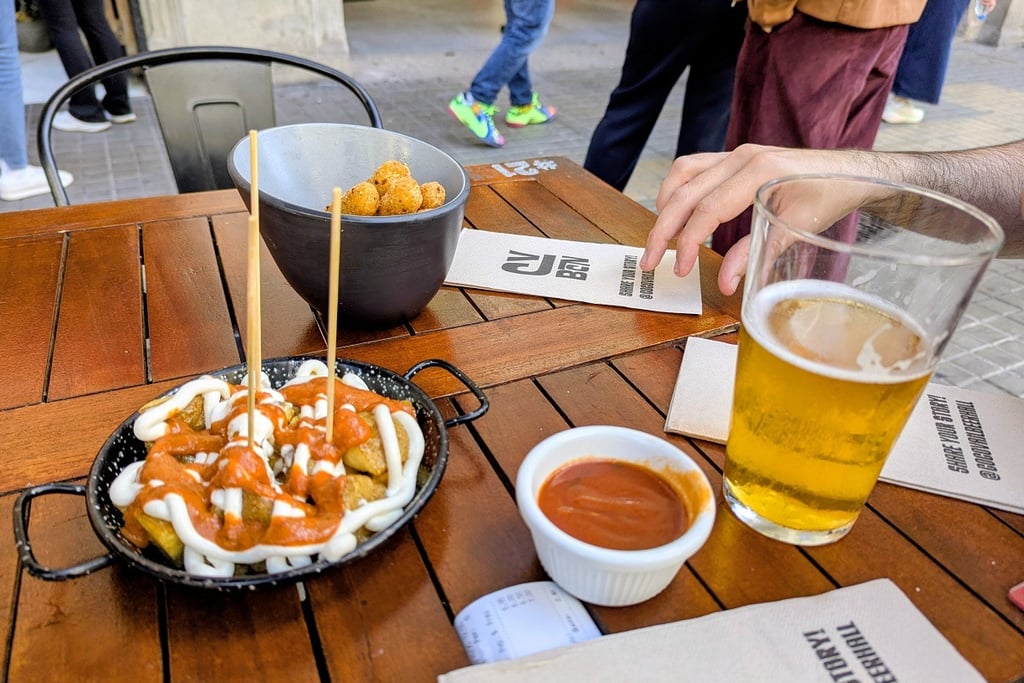

Patatas Bravas and Mozzarella sticks at CocoVail Beer Hall near Passeig de Gracia
Now, you might look at this and think.... that's just patatas bravas and mozzarella sticks! But what differs at CocoVail is that these guys are friggin' sauce masters!! The potatoes in the patatas bravas were perfectly cooked but also smothered in this absolutely gorgeous bravas sauce that seems to maybe have a touch of smoky chipotle in it? Anyhow, it was the absolute best patatas bravas we ever had. Period. Yummie yummie yummie. I salivate as I think about these patatas bravas, they were soooo good! Likewise, the mozzarella sticks were perfectly cooked, the coating had a bit of seasoning on it and the red dipping sauce, while I don't exactly know what it is, was absolutely delicious and complimented the mozzarella sticks SO well!
So what's the verdict for CocoVail Beer Hall - a craftbeer pub Spanish tapas restaurant near Passeig de Gracia metro station? Answer: ⭐⭐⭐⭐⭐
When it comes to bar snacks, I cannot fault this place. I mean, best patatas bravas we ever tasted, and Joe is a biiiiiiiig fan of patatas bravas. Plus, they have a big selection of craftbeers on draft, which is what we like. There is no place in Barcelona we visited as often as this place.
See the restaurant on Google Maps here.
[BACK TO TABLE OF CONTENTS]
Kælderkold Craft Beer Bar - A craftbeer pub in the Gothic Quarter near Liceu metro station
This place is a proper watering hole for craftbeer enthusiasts. They got loads of stuff on tap! We were not sure if they served any food at all, it didn't seem like it, and the place is pretty small. It's popular with locals and tourists alike, though when we were there (middle of the day) there was plenty of seats for us.
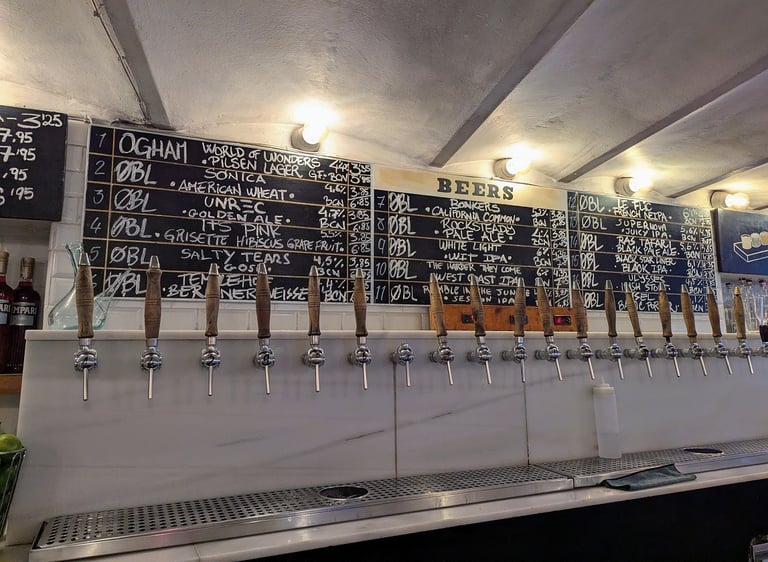
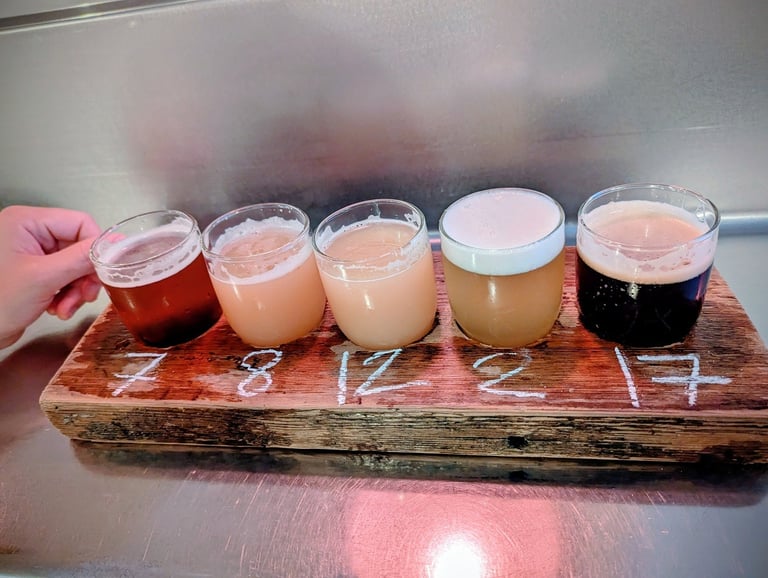


Kælderkold Craft Beer Bar in Gothic Quarter of Barcelona have LOADS of craftbeers on draft
So what's the verdict for Kælderkold Craft Beer Bar - a craftbeer bar in Barcelona's Gothin Quarter near Liceu metro station? Answer: ⭐⭐⭐⭐
It's kinda 3.5 star place to me, just because it's slightly lacking the environment - it feels like an industrial kitchen and the stools at the bar are not comfortable. However, their selection is incredible, and this place is a very welcome break when you've been walking loads all day.
See the restaurant on Google Maps here.
[BACK TO TABLE OF CONTENTS]
La Boqueria - A street food market near Liceu metro station
We had heard of this place before going to Barcelona and people I knew raved about it. The internet typically said it was overpriced and too touristy, a bit of a tourist trap. However, we did poke our heads into the market (OK - we had a decent walk around) to see if we could maybe grab a little snack and a drink somewhere but the place was absolutely rammed. No seats to be had. However, I definitely did enjoy browsing through all the market stalls, even though many of them sell exactly the same thing. I guess certain things are so popular that they warrant a second or a third stall? Below is my video from our visit.

So what's the verdict for La Boqueria street food market next to La Rambla near Liceu metro station? Answer: We don't know, as we didn't get a seat. But it was a fun place to visit regardless.
See the restaurant on Google Maps here.
[BACK TO TABLE OF CONTENTS]
Barcelona is magical and extremely lively at night, with great food, culture, views and vibes. Some of the evening time activities you can do if you find yourself in the same situation as us of arriving late includes the below.
Evening entertainment in Barcelona
Magic Fountain of Montjuïc: Light, music, water show — very iconic, especially for photography and atmosphere. It’s free. Shows run certain nights only, so check schedule ahead. Arrive early to secure a good viewpoint.
Evening walking tour of Gothic Quarter / El Born: Medieval alleys, hidden squares, history, legends — peaceful and lovely under lights. There are tours focused on “ghosts & legends,” or you can wander yourself, stopping by Plaça Reial or small plazas.
Tapas, Pintxos & late dinner: A big part of local culture. Great for people-watching, trying local foods. Try El Born, Poble Sec, Gràcia. Carrer de Blai in Poble Sec is known for good pintxos.
Flamenco / live music nights: Passionate, atmospheric. Something you remember. Los Tarantos is a well known flamenco show spot. Also check Palau de la Música Catalana for concerts. One of the most popular live music venues includes Razzmatazz in El Poblenou.
Rooftop bars & skyline views: Beautiful views of Sagrada Família, sea, rooftops — very romantic or just chill with a drink. Other rooftop bars include:
1881 per SAGARDI, Mediterranean & Catalan cuisine served in an upscale venue at the Museu d'Història de Catalunya. Sunset-to-night transitions are especially nice.
La Isabela at Hotel 1898 on La Rambla 109.
Terrassa 360° at Barceló Raval Stunning panoramic views from the 11th floor over El Raval + sea. Good cocktails & long evening hours. Daily, ~12:00-02:00 (bars stay open late)
Sercotel Rosellón Terrace One of the best views of the Sagrada Família. Instagram-friendly & elegant setting. Evening service; open well into night (exact hours vary).
La Dolce Vitae (Hotel Majestic) Luxury rooftop, gorgeous views (Sagrada Familia etc.), gourmet tapas & signature cocktails. Excellent for a more upscale evening. Open daily from ~11:00-01:30 am.
Terrat on the rooftop of the Mandarin Oriental hotel. Elegant rooftop, views over Casa Batlló, good cocktails, relaxing but classy. Sun-Thurs till midnight; Fri & Sat till ~1:00 am.
The Roof – The Barcelona EDITION Modern, stylish rooftop; good for sunset drinks, dinner, weekend DJ sessions. Evening open (dinner & sunset timings), hours generally into later evening.
Alaire Rooftop Bar Chic, good food + drinks; nice atmosphere at night. Open until ~midnight on most days; later on Thursday-Saturday.
Claris, Hotel Claris Stylish rooftop with full cocktail menu and good food, impressive interiors / ambience. Daily until ~1:00 am.
Beach walk + beach bars / clubs: Sea breeze, relaxed then maybe dancing / drinks. Very Mediterranean night vibe. Barceloneta or Vila Olímpica are good places. In summer many chiringuitos (beach bars) stay open later.
Outdoor cinema / movie under the stars: Lovely in summer; more relaxed pace. Sala Montjuïc is one option. They show films during summer with live music sometimes before.
Night-time bicycle tours: A fun way to see the city light up, get a feel for the layout without getting lost in traffic or crowds. There are organised ones — check local tour operators. Make sure route is safe and you’re comfortable riding at night
Candlelight concerts / special events: When you want a more intimate or atmospheric evening — classical music, special venues, good acoustics. Held in churches or modernist buildings sometimes, or crypts of Gaudí works. Great if you get tickets in advance.
Things to do in Barcelona
Planning a short trip to Barcelona can be a bit overwhelming because there is just SO MUCH to do! But clearly, what Barcelona is famous for and one of the main reasons people come to Barcelona is to see:
The impressive architecture, much of which revolves around the famous Antoni Gaudi, born in 1852 and designed all of Barcelona's most iconic structures, which include:
Sagrada Família
Park Güell
Casa Batlló
Casa Milà (La Pedrera)
Palau Güell
Casa Vicens
Casa Calvet
Colònia Güell (and the Crypt of the Colònia Güell)
Güell Pavilions (Pavellons Güell)
Bellesguard (Torre Bellesguard)
Col·legi de les Teresianes
Portico of the Finca Miralles
Lampposts for Plaça Reial and Plaça Palau
Cooperativa Obrera Mataronense (Mataró Cooperative Factory)
The art museums, which are bountiful in Barcelona and cater to all interests.
The food, which admittetly, is incredbile - just stay away from restaurants on La Rambla.
Below is our itinerary for the 2 full days we had in Barcelona. One thing that we found really helpful was the Barcelona Card, because not only did it include our transfer from the airport into town and back as well as all public transport within the city, but it also included FREE entry into 28 different attractions in the city, plus discounts into several more.
The way we did it was that there are some major attractions in Barcelona that you do need to pay for, sometimes even weeks in advance (like if you want to go inside the Sagrada Familia), so we'd book those tickets where and when needed. But if these attractions were in the same general area as any of the free attractions we were interested in which we could access for free with the Barcelona Card, we could just pop into that museum / check out that attraction at the same time, saving us time, money and making better use of our time in Barcelona. As we were arriving late afternoon on a Wednesday and leaving mid-morning on a Saturday, we bought the 72-hrs ticket so that it'd cover us with public transport and sights the whole time we were there. The card cost us €51.50 (we got it at a discount at the time) per person and it saved us loads of time and hassle, so highly recommend!
When planning your exploration around Barcelona it's worth considering the fact that the vast majority of sights are concentrated around streets Passeig de Gràcia and La Rambla, as well as the Gothic quarter. However there are a few that are a bit out of the way but they are also very much worth seeing, and may be a bit quieter than those on the main drag, because many people won't bother wandering further afield.
When you are deciding when to see each area, you should also consider looking at the cruise ship arrivals at that time, as if there are many large cruise ships docked in Barcelona, there can be unprecedented number of people at each of the big attractions during the period the cruise ships are there. For example, on the two full days we had in Barcelona, on the Thursday there were Viking Saturn (930 px), Celebrity Equinox (2850 px), Tui Mein Schiff 2 (2894 px), MSC Orchestra (2550 px) and Costa Diadema (4947 px) all docked, bringing in an additional 14,000 tourists during the daytime while the ship is docked. On the Friday, it was AIDAcosma (6654 px), MSC World Europa (6774 px) and Costa Favolosa (3800 px), and while there were less ships, their capacity is bigger when full and could mean up to 17,000 additional tourists visiting the city that day. You can see what ships are in town for your dates here.
Seeing as we only had two FULL days in Barcelona, it was imperative that we made the most of our time there - the day of arrival included, even though we were getting in fairly late in the day.
Day 1: Arrival
Perfect evening spoiled rotten with food, drink and entertainment
We flew from Alicante airport with Vueling at 14:04 but the flight was a bit late to depart, arriving atTerminal 1 at Barcelona airport at 15:40. There are lots and several ways to get into Barcelona. See section Getting to Barcelona for details.
Conveniently, we just had hand luggage so we just walked off the plane, past customs, turned right, got our Barcelona Card and then headed out of the terminal to catch the metro to Terminal 2. We then got the train into town, getting off at El Clot train station, which is the closest train station to the hotel where we were staying, Hotel Barcelona Condal Mar Affiliated by Meliá in the Sant Martí neighbourhood in the northern part of Barcelona. It was a strategic mistake, as there were no good connections onwards to our hotel and there was no Uber seemingly wanting to pick us up. So we had the choice between walking down into the Metro next to the station, sit on it for 2 stops and then walk the remaining 15 minutes, or just walk the 30 minutes to the hotel from El Clot station. We opted for the latter as it was less of a faff and we'd get to know a bit of our surroundings. What we should have really done is to get off at Passeig de Gracia train station in town, switch to the metro there and go to Selva de Mar metro station and then it would have just been a 5 minutes walk.
We had a table booked at the LomoAlto steakhouse for 19:30 and by the tune we had checked in to our hotel, dropped off our stuff and decompressed a bit, we took the L4 Metro line from Selva de Mar station back to Passeig de Gracia metro station.
My original plan was to do the following:
Go for a pre-dinner drink at the rooftop bar Terraza La Dolce Vitae at the top of the Majestic Hotel on Passeig de Gracia, overlooking the entire city at sunset.
Go for our steak dinner at Lomo Alto, paid for my American Express Platinum dining credit (we get 2x £100 dining credit to eat abroad, and 2x £100 dining credit to eat out in the UK included in our card fee).
Go for post-dinner drinks at the CocoVail Beer Hall across the road from Lomo Alto for some craftbeers while we waited for our 9pm entry for the Gaudí attraction we were planning to go to.
Go to our 9pm Night Visit at Gaudí's Casa Batlló, which lasts about an hour.
Head back to hotel to sleep.
However, due to the delay in the flight, a bit of hassle getting from El Clot train station to our hotel and the need to decompress a bit after our 30min sweaty walk in the afternoon heat with our (albeit small) luggage, we didn't really have time for the rooftop bar (as there are records of you sometimes having to wait a bit to be allowed up when it's busy) but we did manage to sneak in a cheeky craftbeer at the CocoVail Beer Hall before dinner, as it was just across the road from the steakhouse. I must say, their own Coco Vail IPA is EXCELLENT! BTW - if you are a craftbeer enthusiast like me, follow me on Untappd!


Joe happy with the first proper craft beer he got since arriving in Spain at Cocovail in Barcelona
We went to dinner at Lomo Alto (which was incredible!!!), described in the food section above for the foodies!
After dinner, it was time for our 9pm night visit at Gaudi's Casa Batlló, just a few steps from the restaurant. Antoni Gaudí (1852–1926) was a Catalan architect whose work is considered among the most distinctive and imaginative in modern architecture. What makes Gaudí’s architecture special is how it fuses nature, structure, and spirituality into a completely unique language of design. Gaudí believed that nature is the greatest architect, and he drew from it constantly, using organic forms, geometry of nature such as natural mathematical forms like parabolas, helicoids and hyperboloids. He integrated beautiful mosaic tilework from broken ceramics and glass which shimmer in the light. There are many of his famous designs in Barcelona and we were just about to experience one of them for the first time!

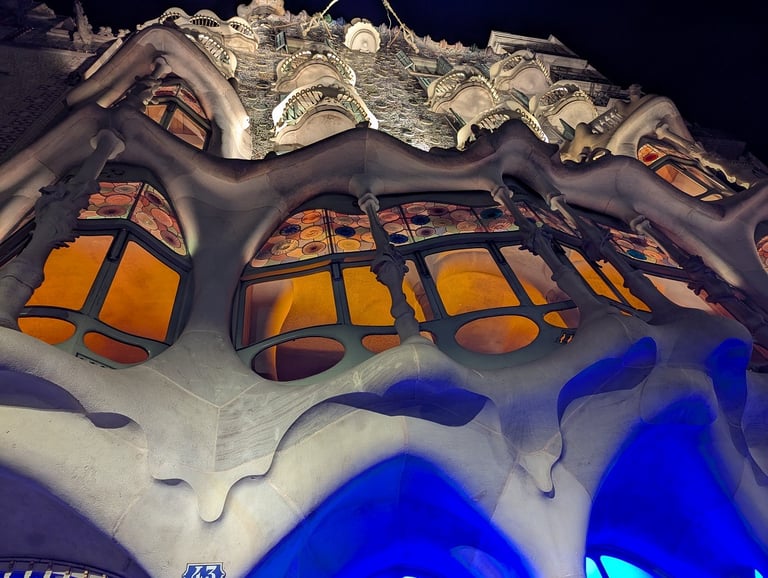


Gaudi's Casa Batllo on PAsseig de Gracia in Barcelona
Approaching the Casa Batllo in the night lights was a bit like walking into some sort of fairly tale. The place is quite magical, weird and quirky. There are so many intricate details to admire in every tiny corner of the building.
We were given an audio guide that told us about the house and when we arrived in the main hall we were also given a glass of sparkling wine (but non-alcoholic options also available).

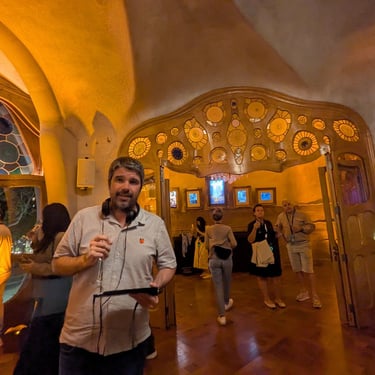
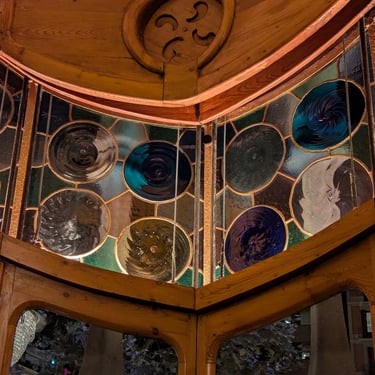

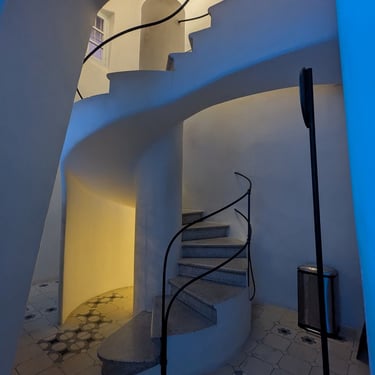

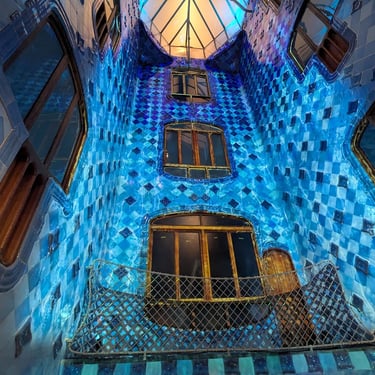
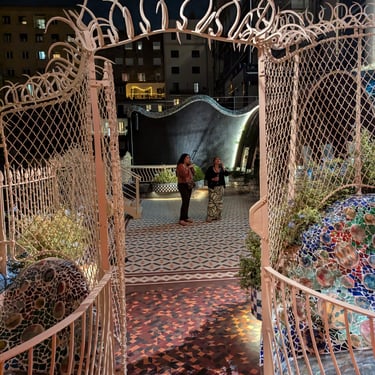
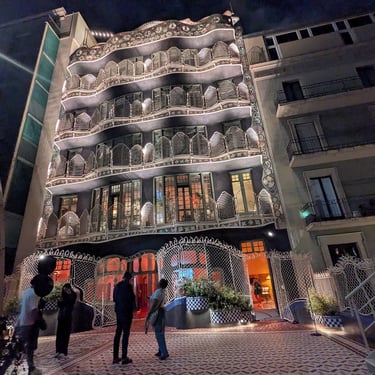

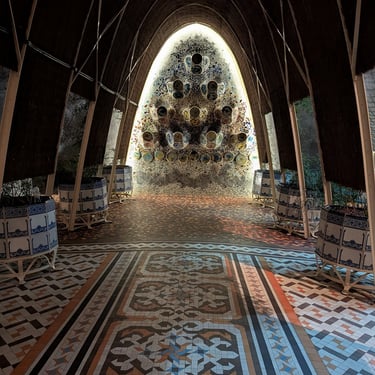
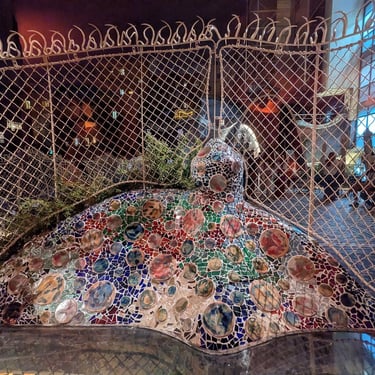

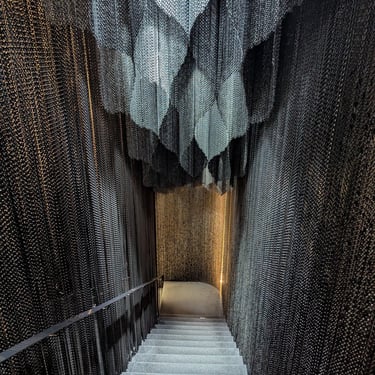

The weird and wonderful Casa Batllo by Gaudi in Barcelona - photos from our night visit
When you purchase tickets you can choose between Blue, Silver, Gold and Platinum tickets, which let you into different parts of the house. The Silver ticket also included a tablet that was meant to provide an "augmented reality", but in reality it was just quite lame and not worth the extra €5 EUR we paid for the ticket. The Silver and Blue tickets also visit all the same best parts of the house, with Silver tickets also getting to see what is called the concierge and Gaudi dome, but I didn't even realise that it was anything special, the other parts were better. Therefore, I'd probably just recommend getting the Blue ticket over the Silver. The other tickets are just plain over priced.
Note that if you are planning to do the Night Visit, it only runs in the summer and into the autum with the last day being 10th November. Also note that the tickets can ONLY be purchased online and not at the door, therefore the €7 EUR discount from the Barcelona Card is only valid during the daytime visit. What I will say is that we were super glad we chose to do the night visit, as it was magical and a lot more quiet. We saw the place the next morning and there were just queues all over the place. It might be really nice in the daytime too with the sunlight beaming through the windows, but we were very happy with our night visit and it was one of the most memorable things we did in Barcelona, so we both highly recommend it! Below is a short reel from our magical night time visit to Casa Batlló.

Day 2: Full day in Barcelona
Our second day was a Thursday, so we thought we'd focus on the places that were likely to be very busy with weekenders (and thus avoiding visiting those places on the Friday). That clearly meant that this was going to be our Gaudi-day. That being said, there's only so many Gaudi houses you can see, because they are quite expensive to get into (pretty much always over €20 EUR per person to go inside).
We also had a lot of other things to see in the short time we had in Barcelona, so we had to take full advantage of the day. Unfortunately, it was also forecasted to be a rainy day, so lots of walking outside wasn't going to be particularly pleasant, nor were any rooftop activities, which was unfortunate as we had missed out on our rooftop terrace drinks the day before.
In the end, the plan for the day was the following:
Breakfast at the Melia (our hotel)
Using our Barcelona Card to take the metro into town from Selva de Mar station and get off at Jaume 1 station.
See the cluster of museums in El Born that we were interested in. We were aiming for at least the Moco Museum and the Banksy Museum, but depending on the time scale, we wanted to try to fit in the Picasso Museum before lunch.
Using our Barcelona Card to take the metro from near Banksy Museum at Urquinaona to Urgell.
Lunch at the Chilean restaurant El Vuit right outside Urgell station. Yum! (see details here)
Using our Barcelona Card to take the metro from Urgell station to Plaza Catalunya where we changed trains to go to Fontana metro station in the Gracia neighbourhood, the station is practically next to the Gaudi house Casa Vicens.
Using our Barcelona Card to get 20% off the entrace to the Casa Vicens.
Walk from Casa Vicens to Park Güell (25 minutes) with a pitstop for a drink somewhere on the way.
Be at Park Güell for our 18:00 entry slot.
Dinner at a Peruvian restaurant at 20:00 (or so we thought!)
Big morning of museums
We started our first full day in Barcelona visiting some of the most famous museums in the city, including the Moco Museum, Picasso Museum and the Banksy Museum.
Museu Moco Barcelona
We started our morning of exploring going to the Moco Museum Carrer de Montcada in the El Born neighbourhood, which is by far the most interesting museum in Barcelona in our opinion, but people into more classic things may disagree. I just find it generally more colourful, playful, curious, fun and/or thought-provoking than the more classical arts. It was also great value with our Barcelona Card - Free entrance instead of the €19.95 EUR per person that it would have cost us on the day. The exhibiting artists include Banksy, Yatoy Kusama, Andy Warhol, Keith Haring and Jean-Michel Basquiat, among others.

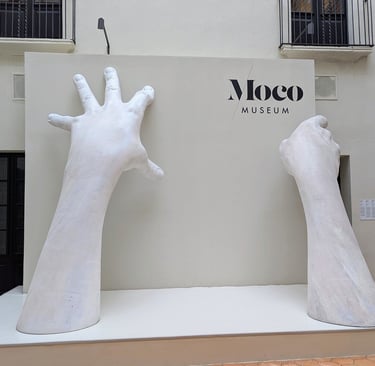
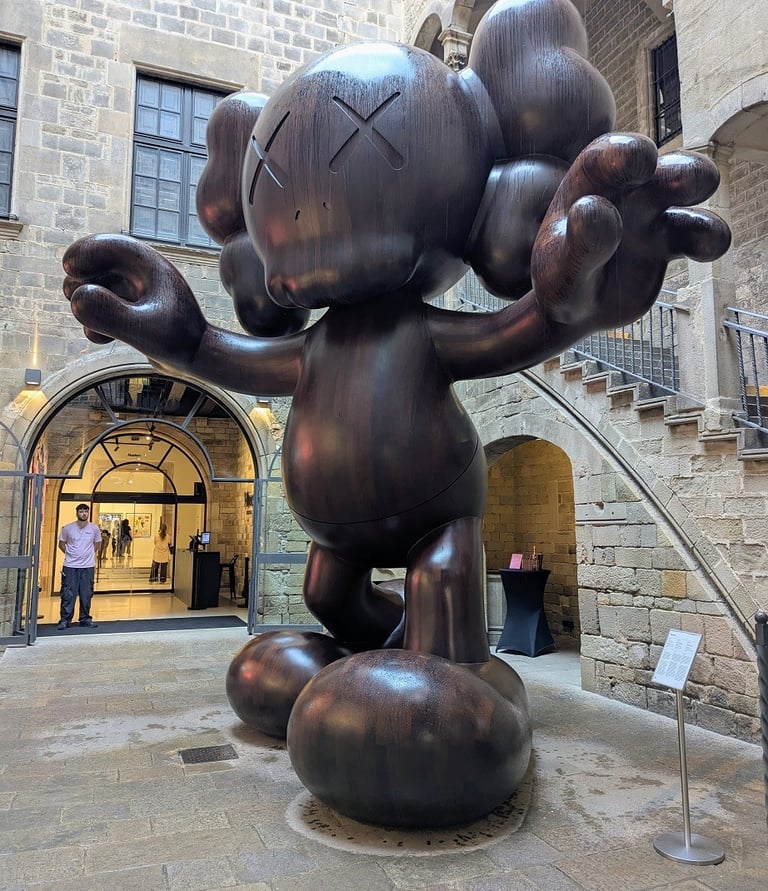

The entrance to the Moco Museum features the KAWS statue "Final Days", carved from afrormosia wood.
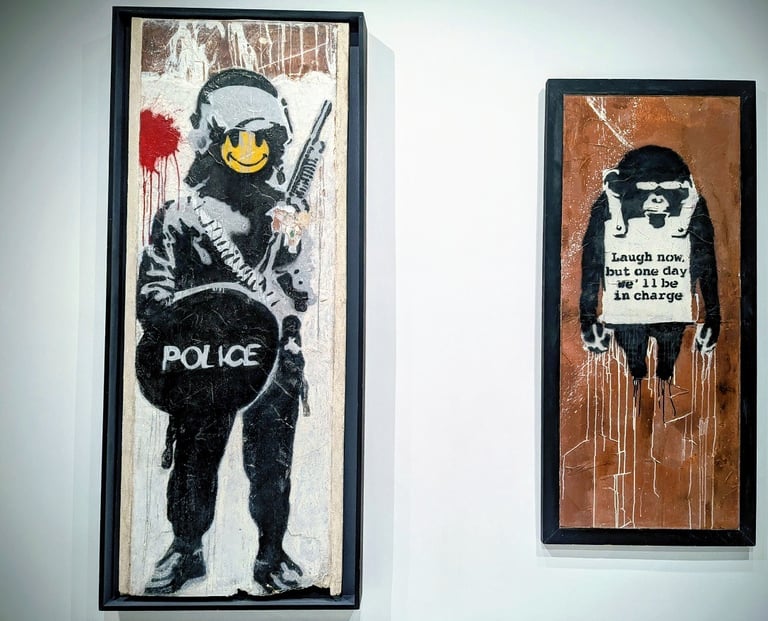

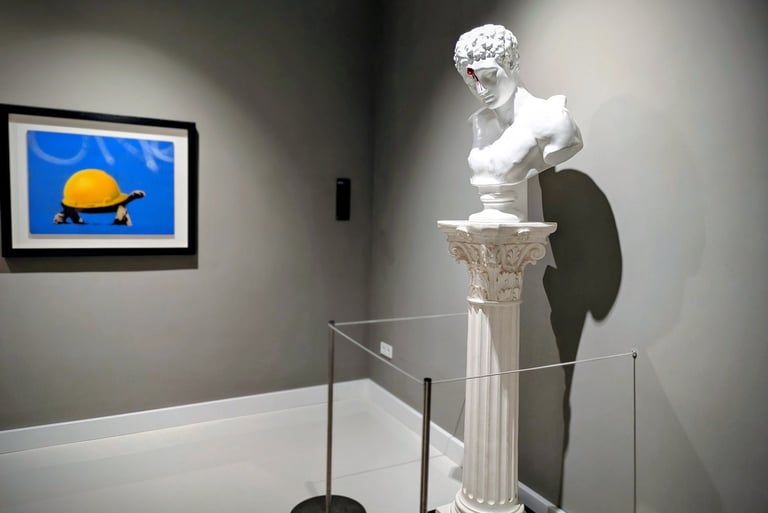

There are a few pieces by Banksy at the Moco Museum
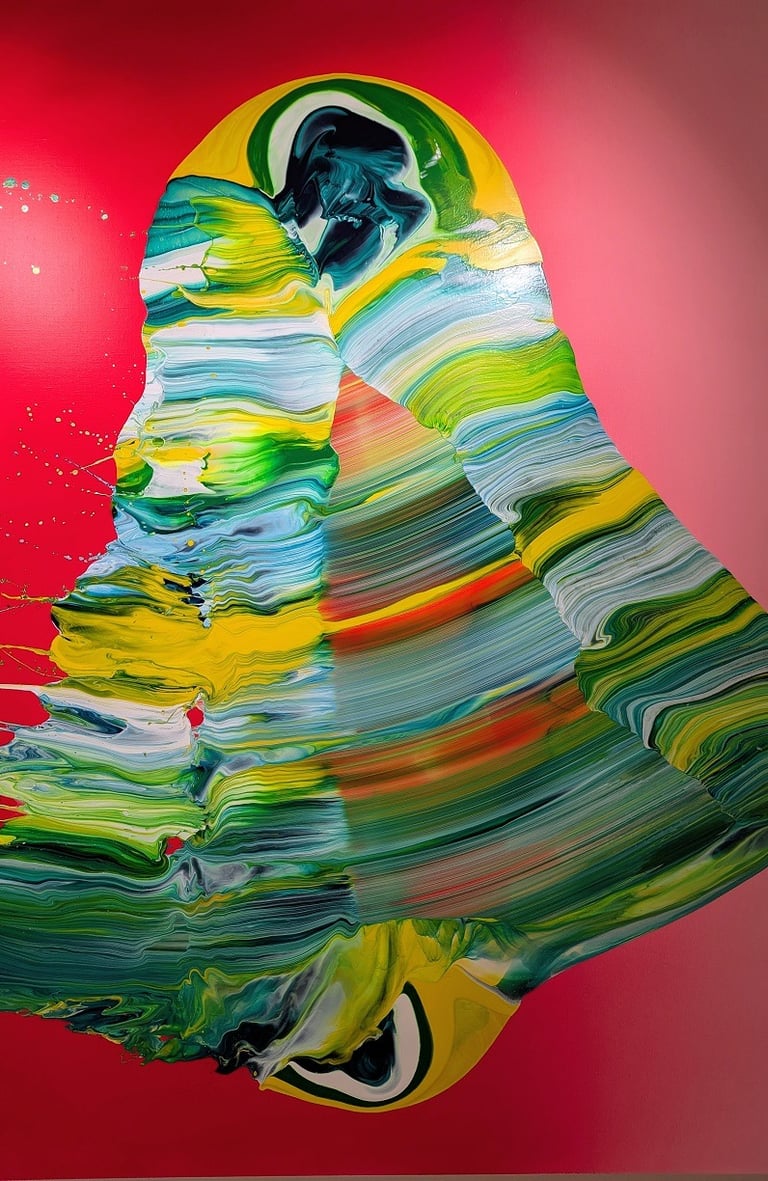

This piece by Yago Hortal was weirdly hypnotising


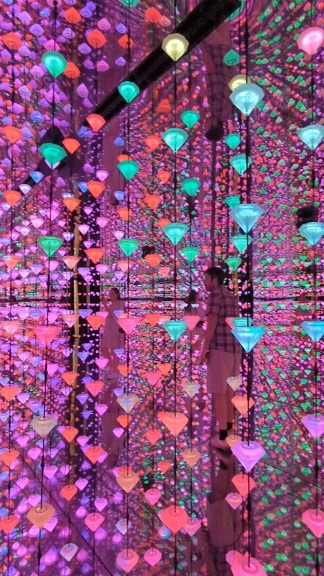

Inside the multi-sensory experience immersive infinity room "Diamond Matrix" by Studio Irma .
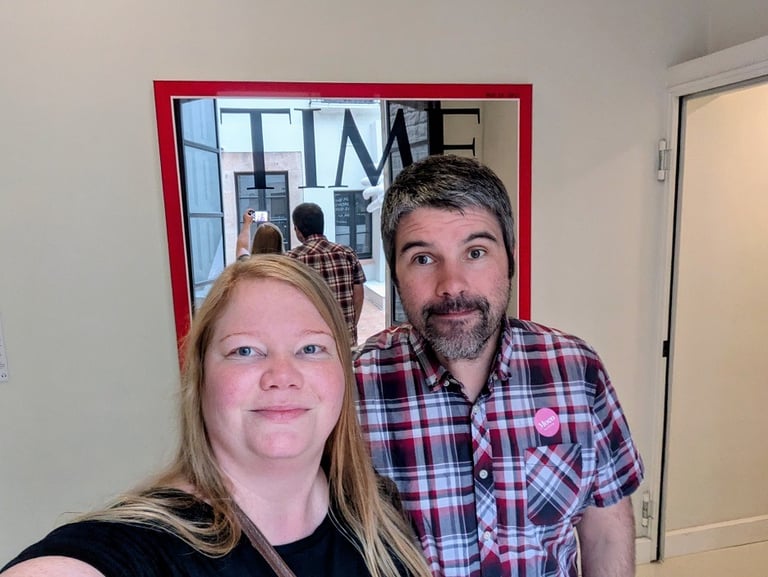

At the end of our visit at the Moco Museum
When you enter the Moco Museum, they give you tickets for €5 EUR off at the museum shop where you can buy prints of the many pieces of art they have on display in the museum, along with a fair few fun souvenirs, like wildly pink Moco mugs, among many other things. However, just a word of warning that if you ARE planning to buy Banksy prints, as we were looking into doing, they are WAY cheaper at the actual Banksy Museum #toptip.

Museu Picasso de Barcelona
The Moco Museum isn't terribly big, which meant we had some time to go to the Picasso Museum as well further down the road on Carrer de Montcada street, before we headed to the Banksy Museum. It must be said that the El Born neighbourhood where all these museums are located is really quite charming!

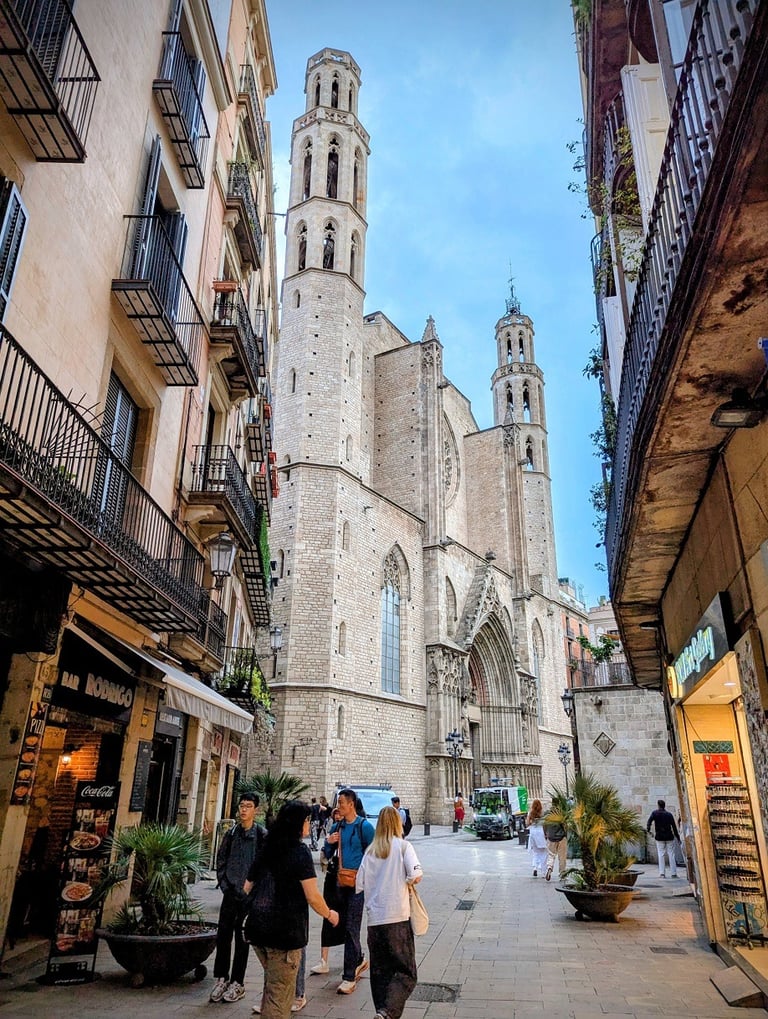


Walking between the different museums in El Born neighbourhood of Barcelona
Again we saved on the entrance fee going to the Picasso Museum for free with the Barcelona Card rather than paying €14 EUR entrance per person. We're not necessarily fans of Picasso but it was definitely interesting seeing the different phases the artist went through in his life, seeing the paintings change as time passed.
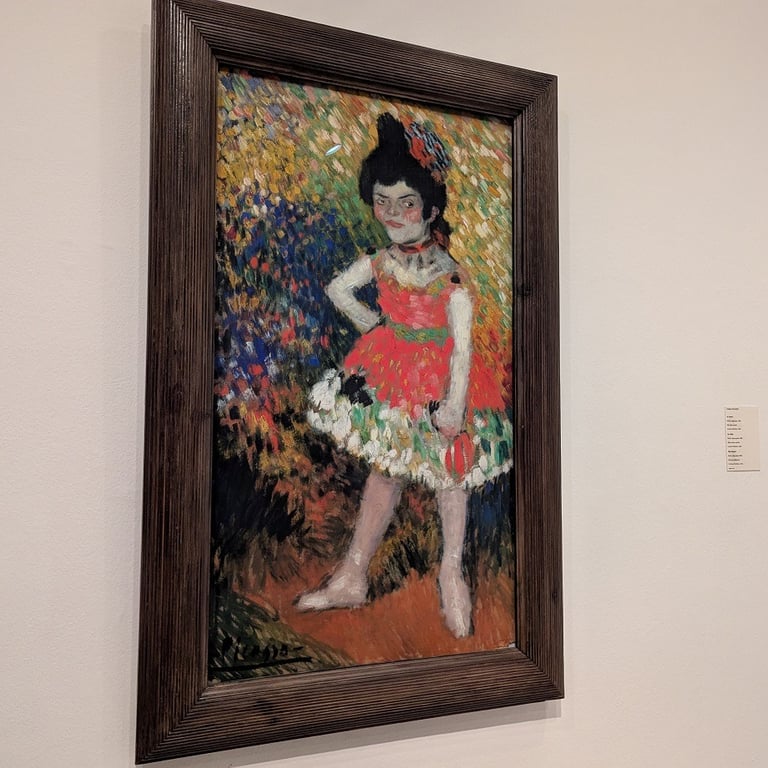
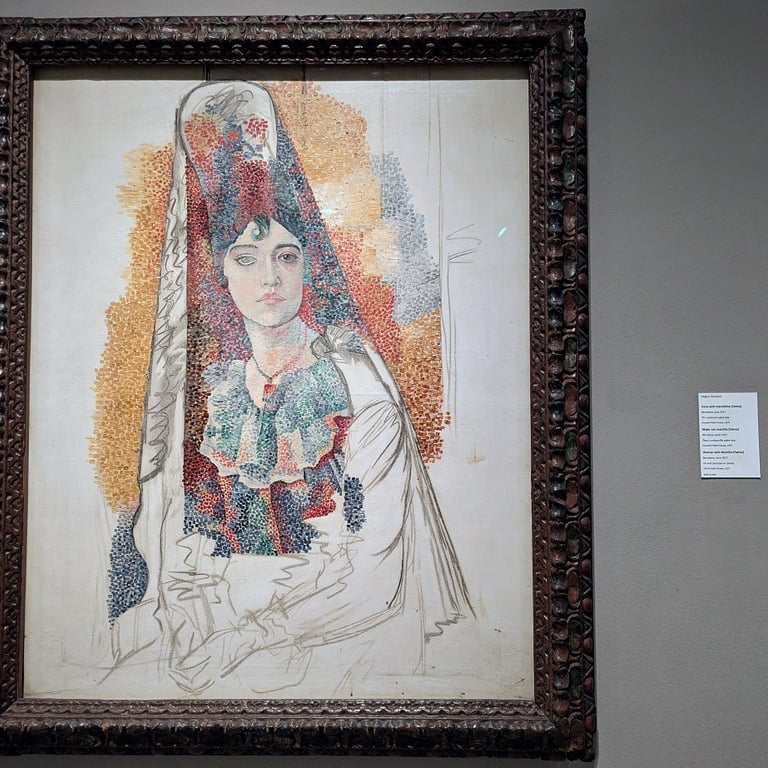

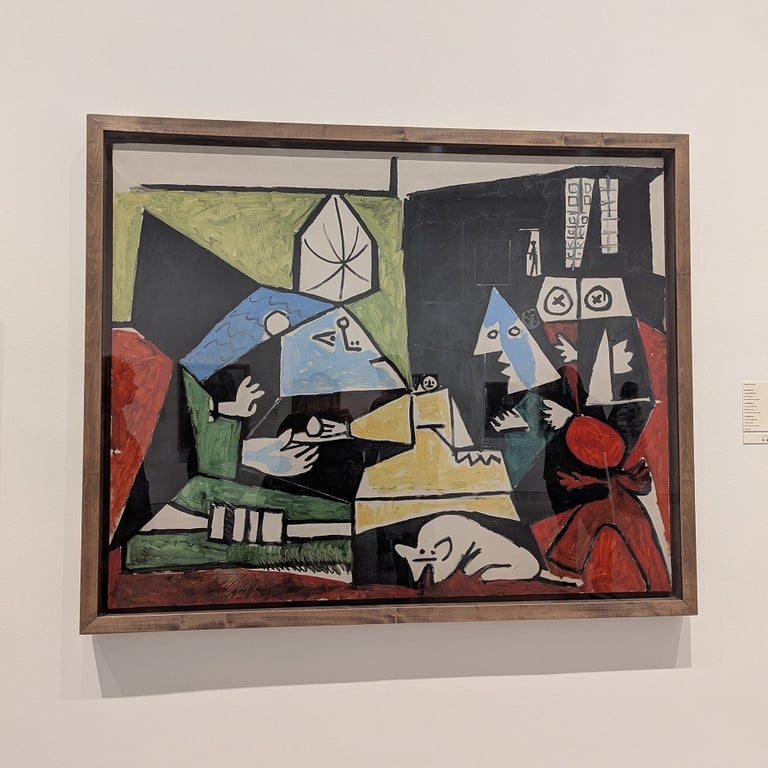
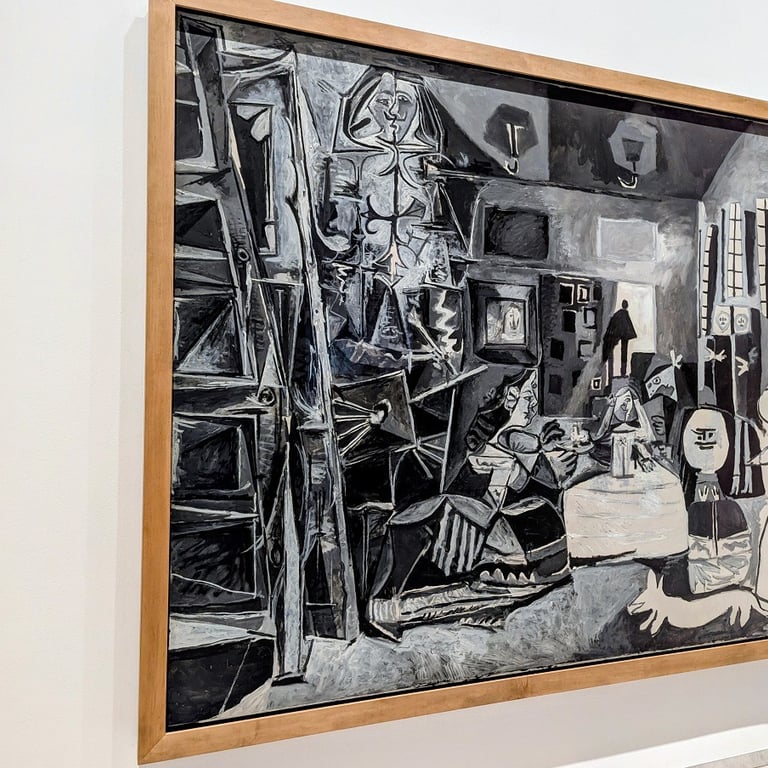
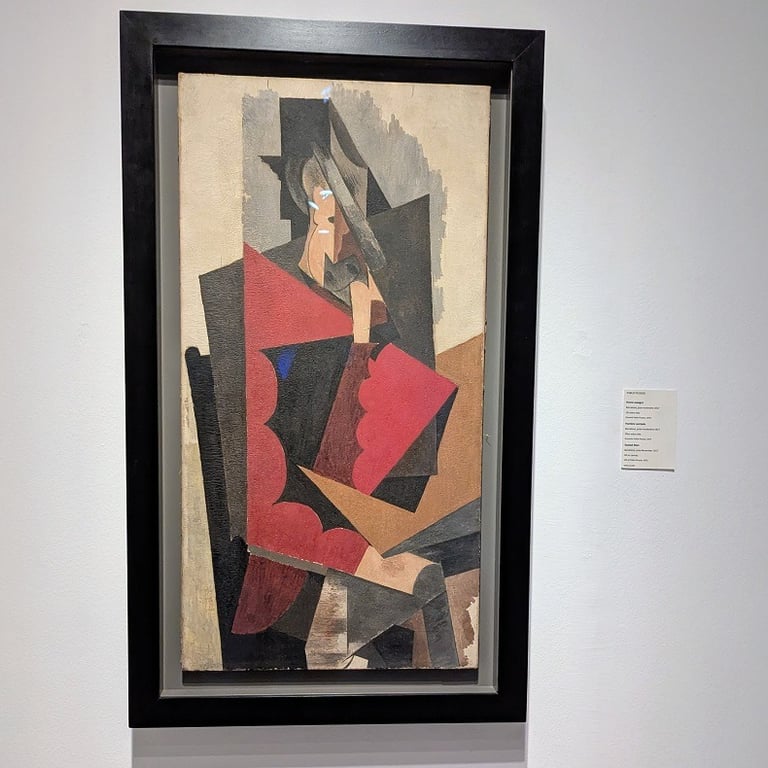
Artwork on display in the Picasso Museum in Barcelona
The inside of the museum building is also very pretty. I would recommend visiting the Picasso Museum, especially if you have the Barcelona Card, as it's a very worthwhile place to visit, as you're not paying anything extra on top of what you've already paid.
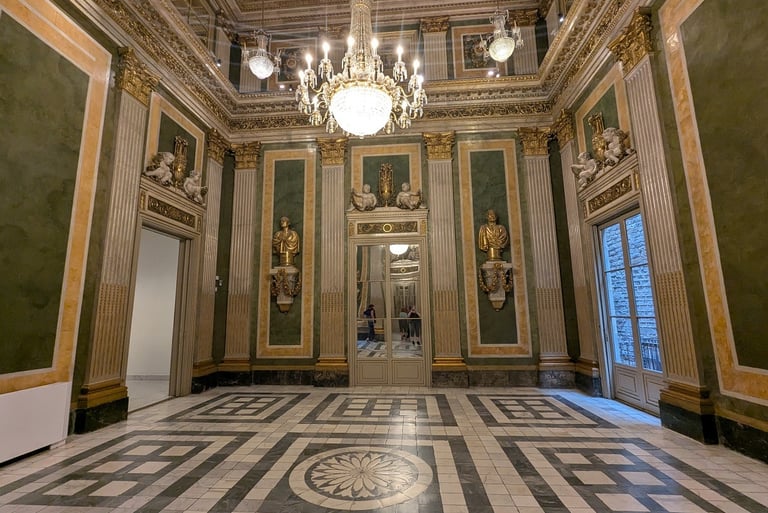


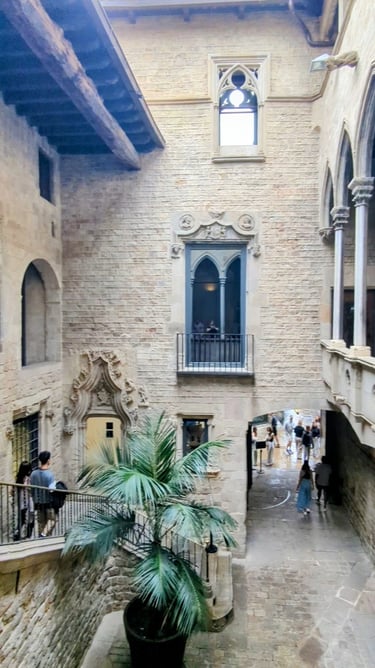
The elegant interior of the Picasso Museum
Banksy Museum
Our final stop on our El Born museum hopping this morning was the Banksy Museum, located on Carrer de Trafalgar. It is as it says on the tin - a museum dedicated to the work of Banksy. When it comes to modern art, I'd say he's definitely up there with my favourite artists, with his pieces always hitting hard using satire and irony when it comes to pointing out the nuiances in life, criticising consumerism, war, surveillance and societal hypocrisy. The museum is also included in the Barcelona Card, saving us another €14 EUR entrance fee per person.
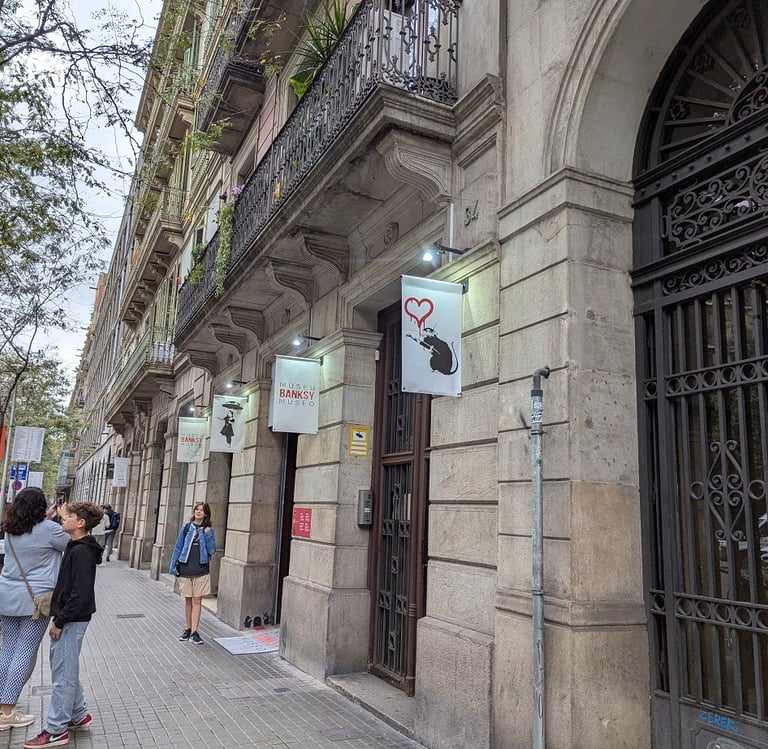

The entrance to the Banksy museum in Barcelona
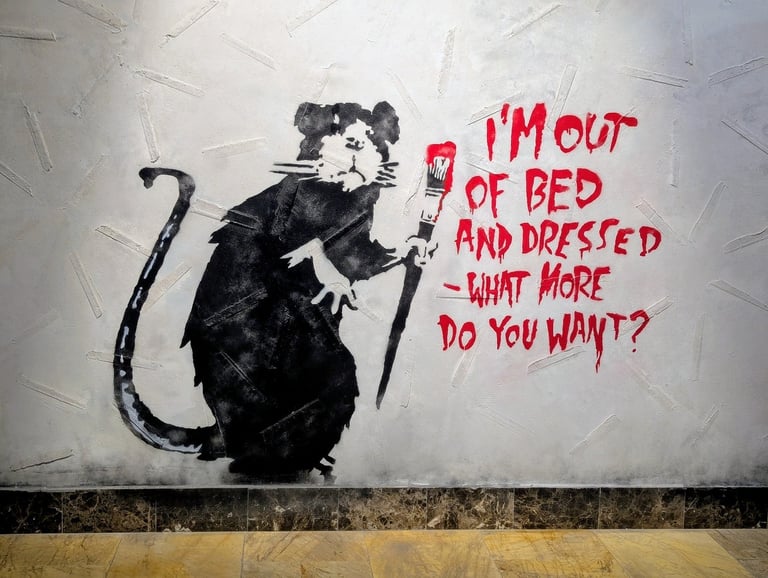
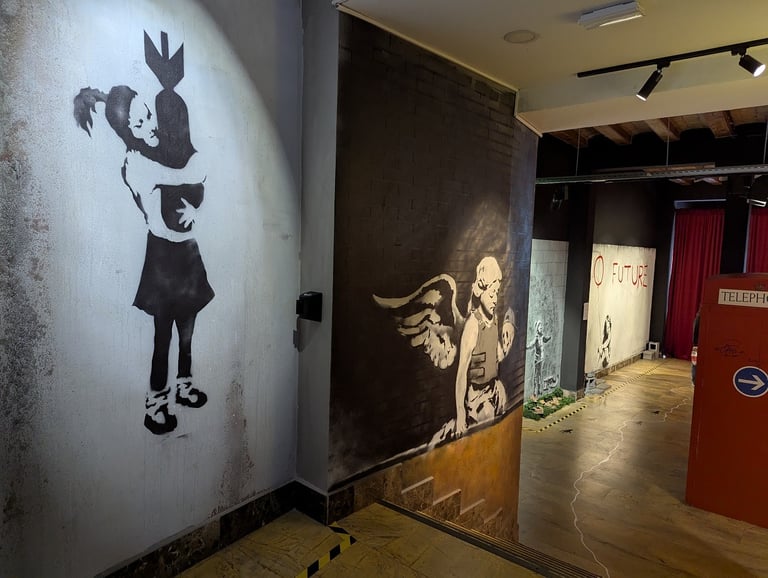



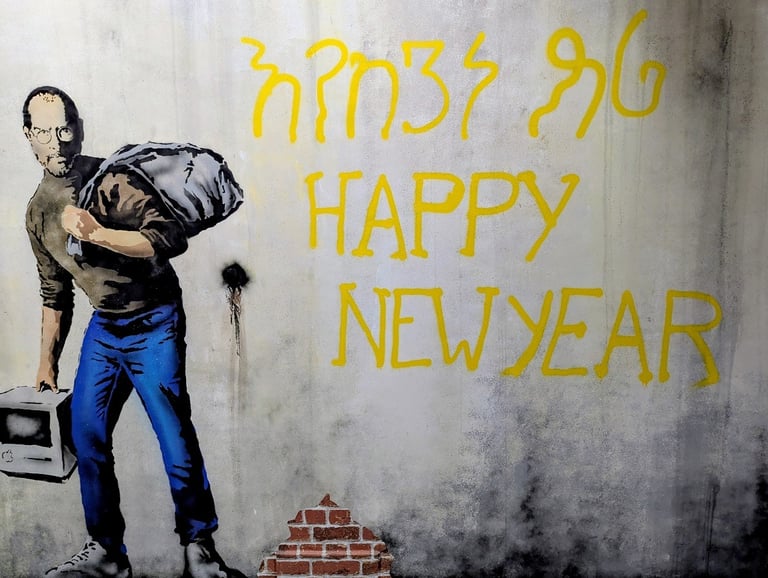
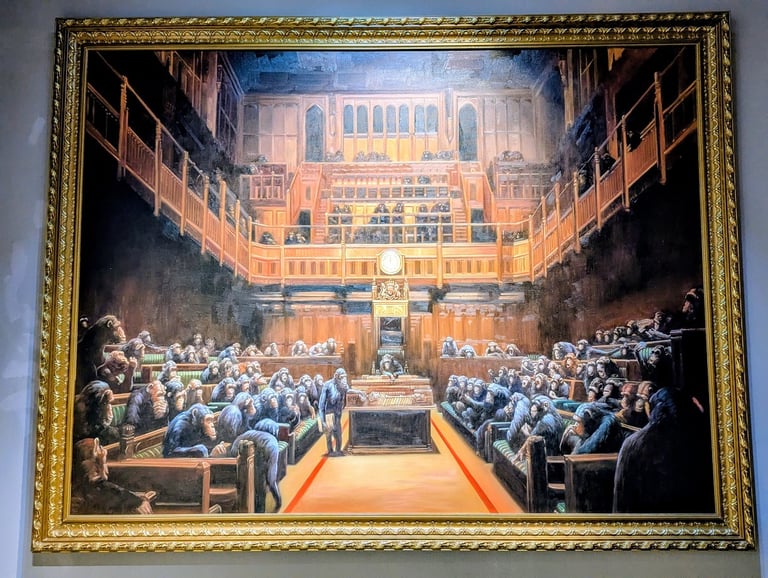
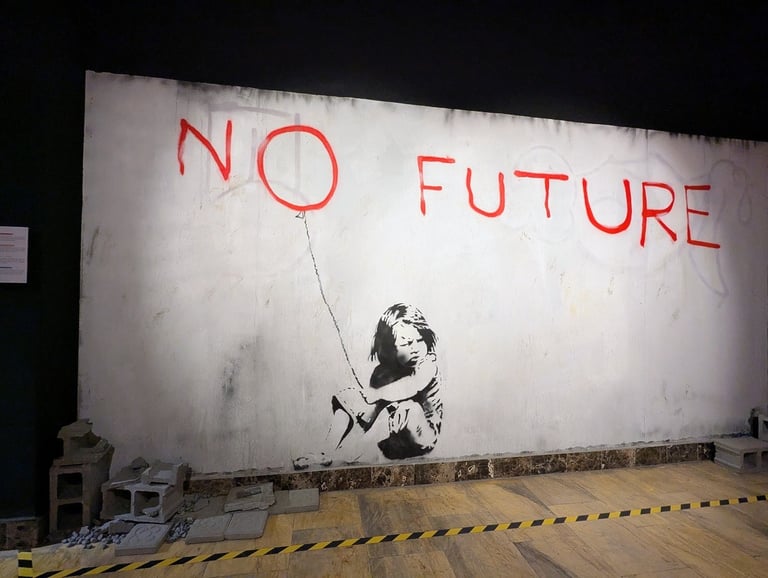








Some of the many pieces of art on display at the Banksy Museum in Barcelona
The Banksy Museum is really well set up and surprisingly big, with all of the most iconic images produced by Banksy. At the end of the walk around the museum there's the museum shop as usual, but they sell Banksy's prints much cheaper compared to the Moco Museum, so if you're planning to buy one, definitely do it there! You can always return to the museum shop at a later date, in case it is not convenient for you to buy anything there and then, as the shop has a separate door at the back of the museum (access from Carrer de Sant Pere Mes Alt street)
It was just a 4 minute walk from the back of the Banksy Museum to the Urquinaona Metro station, where we jumped onto the L1 line and rode 4 minutes towards direction Hospital de Bellvitge and got off at Urgell Station, which is just outside the Chilean El Vuit Gastronomic where I had excitedly been waiting for us to go to for lunch. Restaurant stuff is covered in the section above.
An afternoon of Gaudí
After lunch, we had plans to visit two of Gaudi's masterpieces: Casa Vicens in the Gracia neighbourhood and Park Güell. I had booked us a 6pm slot for Park Güell just in case it would sell out, especially as there was no benefit to just showing up at the door to buy a ticket - the Barcelona Card offers no discounts here.
Casa Vicens Gaudi
We started after lunch by taking metro line L1 at Urgell Station towards Fondo but getting off 2 minutes later at Plaza de Catalunya and changed to metro line L3 in direction of Trinitat Nova riding it for 5 minutes and getting off at Fontana, from where it was a very short walk to Casa Vicens. The Barcelona Metro is great! Once you approach Casa Vicens, which you'll recognize instantly.
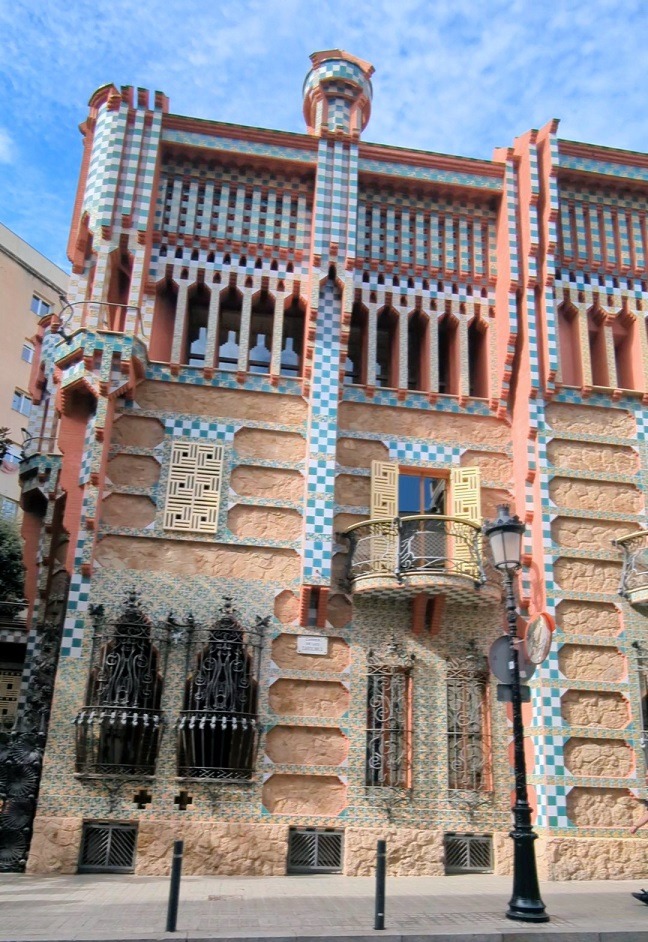

Casa Vicens seen from the street before you enter
Casa Vicens was Antoni Gaudí’s first major architectural commission and a defining work in the birth of Catalan Modernisme. Built between 1883 and 1888 for stockbroker Manuel Vicens i Montaner, the house marked Gaudí’s transition from traditional historicism to his own distinctive, nature-inspired style. Combining Moorish, Orientalist, and Gothic influences, Gaudí designed a vibrant residence that celebrated color, light, and natural motifs. Its striking green-and-white ceramic tiles, wrought-iron palm leaf gate, and geometric brickwork reflect both craftsmanship and symbolism drawn from the plants that originally grew on the property.
Originally a summer retreat, Casa Vicens remained a private residence for over a century before opening to the public as a museum in 2017, following an extensive restoration. Today it stands as a UNESCO World Heritage Site and a vivid example of Gaudí’s early genius; a synthesis of art, architecture, and nature that foreshadowed his later masterpieces like Park Güell and the Sagrada Família. The house’s playful patterns, intricate details, and harmony with its surroundings make it not only a cornerstone of Gaudí’s career but also one of Barcelona’s most captivating yet underrated architectural treasures.
When you come here with a Barcelona Pass, you get 20% off the entrance fee. When we arrived here after lunch, there was absolutely no queue, we just walked straight into the ticket office and into the house. There was plenty of space to walk around and enjoy this amazing site - the house and the garden is absolutely gorgeous.
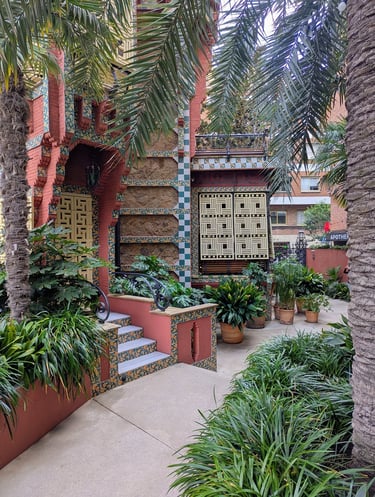

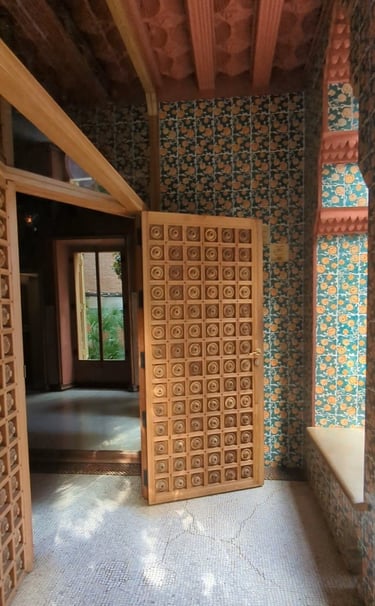
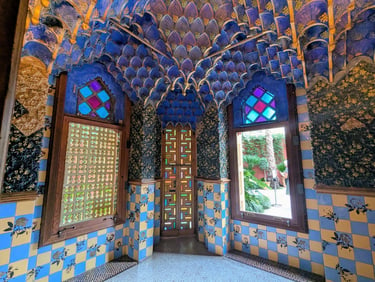
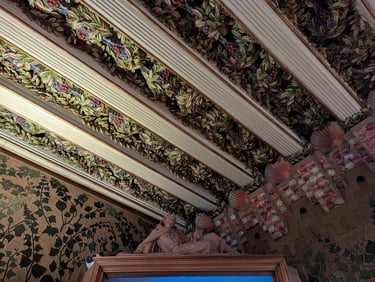
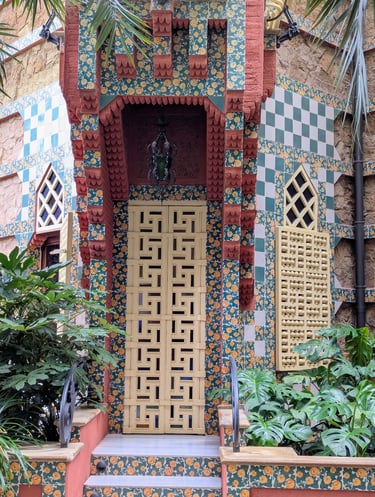

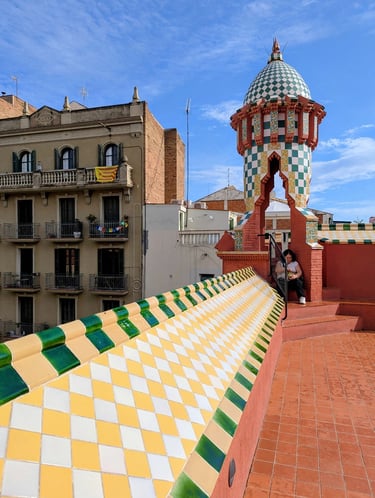










The beautiful interior of Casa Vicens by Antoni Gaudí
Our visit to Casa Vicens was totally worthwhile and I'd recommend anybody to come and see this beautiful building. It is a lot more quiet than the other designs by Gaudí and I would highly recommend that you start here if you're visiting several Gaudí attractions, because while this place is absolutely gorgeous, if you make it your first stop it will blow your mind! Though on the flip side, you might not realise how lucky you got it when you're there, as you won't have experienced already how extremely busy some of the other sights can be and how wonderfully calm and peaceful this place is.
Park Güell
Public transport to Park Güell can be a bit awkward, especially if you're not one for using buses. The nearest metro station is Lesseps, from where it's a 15 minute walk, half of which is uphill. You can catch the metro taking you to Lesseps by taking the L3 metro line at Fontana practically outside Casa Vicens in direction of Trinitat Nova and get off at the next station, or alternatively if you're on La Ramba or Passeig de Gracia you can take the same metro line in the same direction (Trinitat Nova) from Plaza de Catalunya , Paza de Catalunya or Liceu, whichever one is closest.
However, we didn't bother riding a single stop on the metro. We just started walking towards Park Guell after Casa Vicens, as we had some time to kill. Without stops, the walk takes about 25 minutes. On the way we stopped at a small restaurant to hydrate ourselves after the (fairly long) walk, Joe with a beer but I was more in the mood for some Red Bull with ice.
We had booked a slot for the 6pm entry to catch the "Golden hour" when the sun is setting, as well as skipping the hordes of cruise ship passengers that had already gone back to their ship by this point and the sunset gives the place a special glow. However, the pesky clouds were getting in the way of my nice sunset! As mentioned earlier, there's no discount with the Barcelona Card and purchasing tickets online in advance is recommended to avoid disappointment. The ticket cost us €36 EUR for the two of us on the official Park Guell website and we just showed the electronic ticket on my phone on entry.
Despite the threat of rain while we were in the park, the walk around it was amazing. It's like some kind of weird fairytale land.
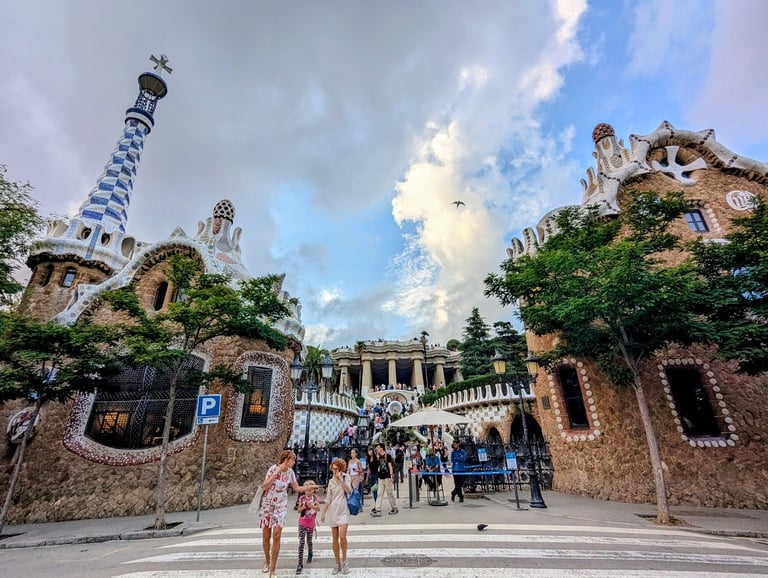
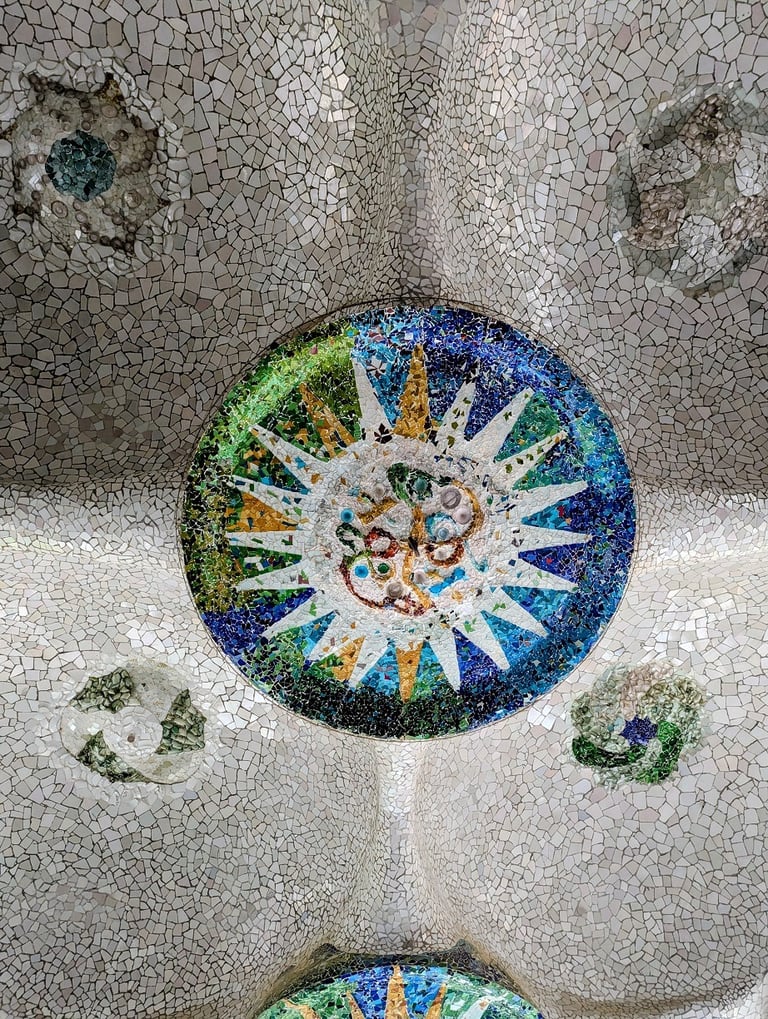
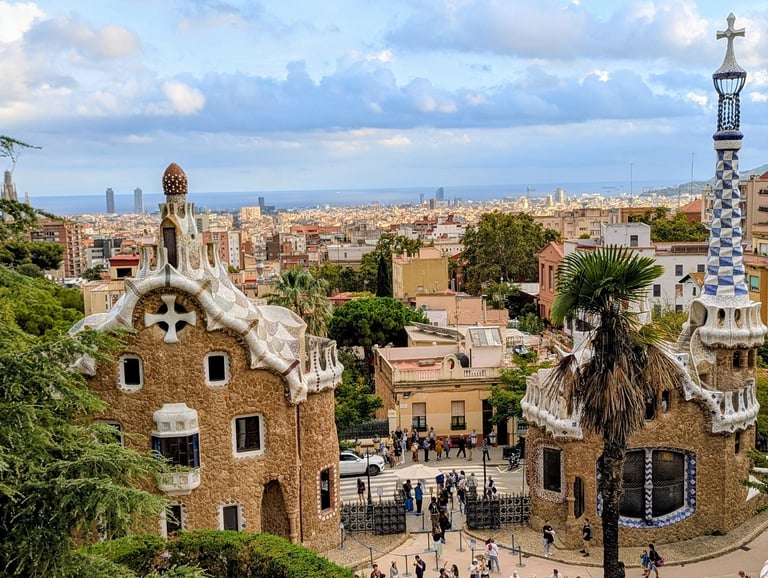
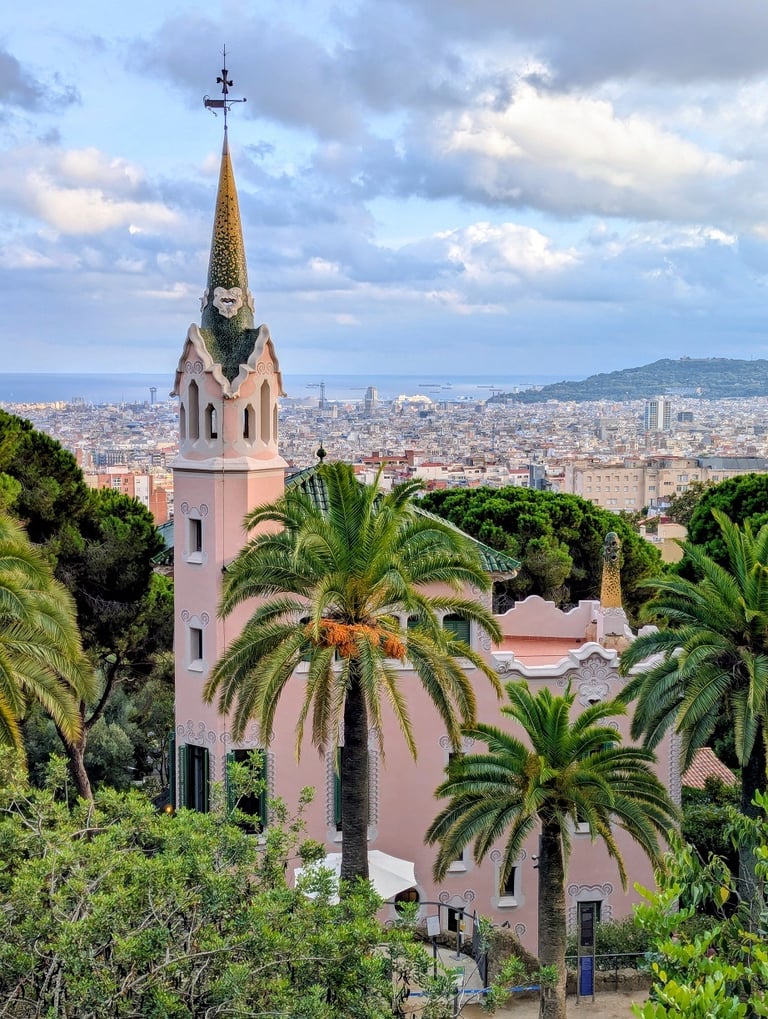


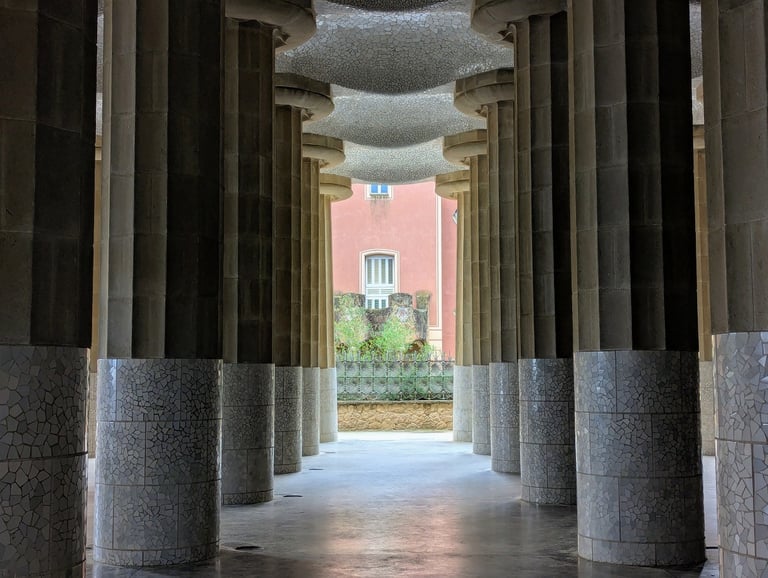
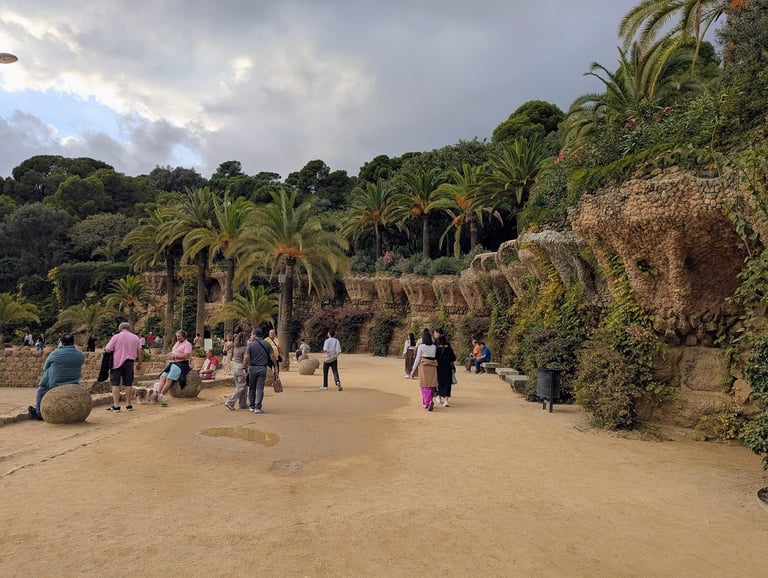
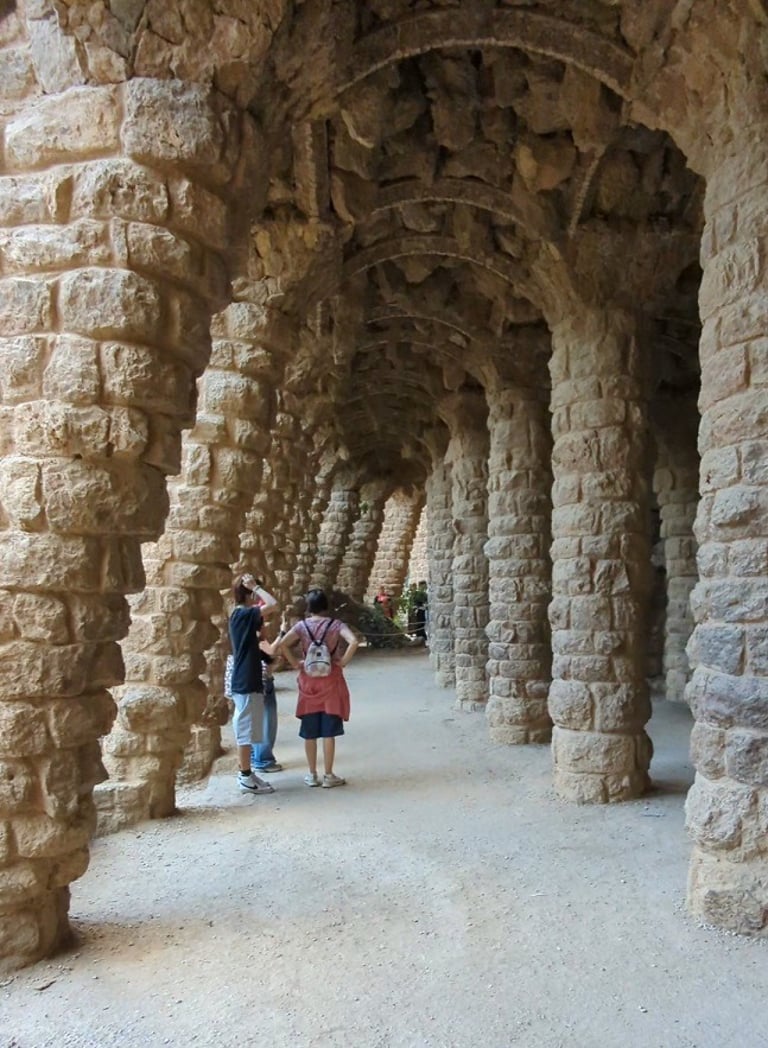
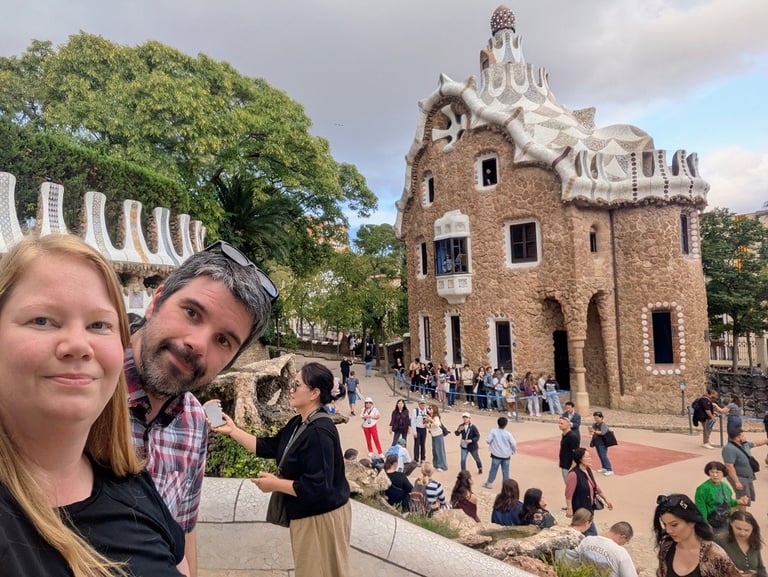










Gaudí's FAIRY TALE LAND OF Park Güell
The park is perched on Carmel Hill and is one of Antoni Gaudí’s most iconic creations. It was commissioned by industrialist Eusebi Güell between 1900 and 1914. The park was originally intended as a private garden city inspired by English garden towns, but the project was never completed and later became a public park. Gaudí transformed the rugged hillside into a vivid fantasyland where architecture and nature blend seamlessly using organic shapes, vibrant mosaics and flowing stone structures that mimic natural forms like trees, waves, and animal figures. Every element, from the serpentine benches of the main terrace to the famous dragon (or salamander) at the entrance, demonstrates Gaudí’s inventive use of color, texture, and symbolism rooted in Catalan identity and the natural world.
The park was declared a UNESCO World Heritage Site in 1984. It is not just an architectural wonder but also reflects Gaudí’s deep ecological and spiritual vision, integrating recycled materials and advanced engineering techniques to create functional yet poetic spaces, like the viaducts that follow the terrain’s contours and the hypostyle hall that supports the terrace above. The park’s incredible views of Barcelona, combined with its imaginative design, make it one of the city’s most visited landmarks, and for good reason.
By this point we had both mentally and physically run out of juice and needed to just get back to the hotel to chill out for a little bit, then grab a nightcap at the local Tapas bar next to our hotel with some snacks on the side, and that was us done for the day.
An attempt to a Latin American inspired evening
We had grand plans of having a very Latin American inspired evening, with dinner at a Peruvian restaurant. However, we were still absolutely stuffed after our Chilean feast at lunch time, so instead we headed to the Gothic Quarter for a drink at the famous (in certain circles!) Bar Mariatchi. The musician Manu Chao co-founded Bar Mariatchi in the late 1990s/early 2000s. It started as a bohemian hangout spot for artists, travelers, and musicians; informal, creative and a bit underground. The bar reflects Manu Chao’s spirit: vibrant, multicultural, rebellious and infused with music. The décor is eclectic, often with photos, posters, and references to social causes. Although Manu Chao doesn’t run it day-to-day, he is still associated with its identity and sometimes he has been known to drop by or even play impromptu acoustic sets. Because of his link, Bar Mariatchi has become a cultural landmark for fans like myself. I clearly couldn't miss out on visiting this bar!
However, when we got there, after having walked 26,000 steps during the day and our legs literally... on their last legs... *pun * the fact that there were no seats available meant that as much as I wanted to stay and listen to the very good musicians that were playing music similar to what you'd hear Manu Chao play (although no Manu Chao there this time!), we were literally shattered and in dire need of a seat. So, extremely sadly, we had to leave. I felt like we made the musicians sad by leaving, as if we didn't want to listen to them, but I so wanted to stay! We just really could not.
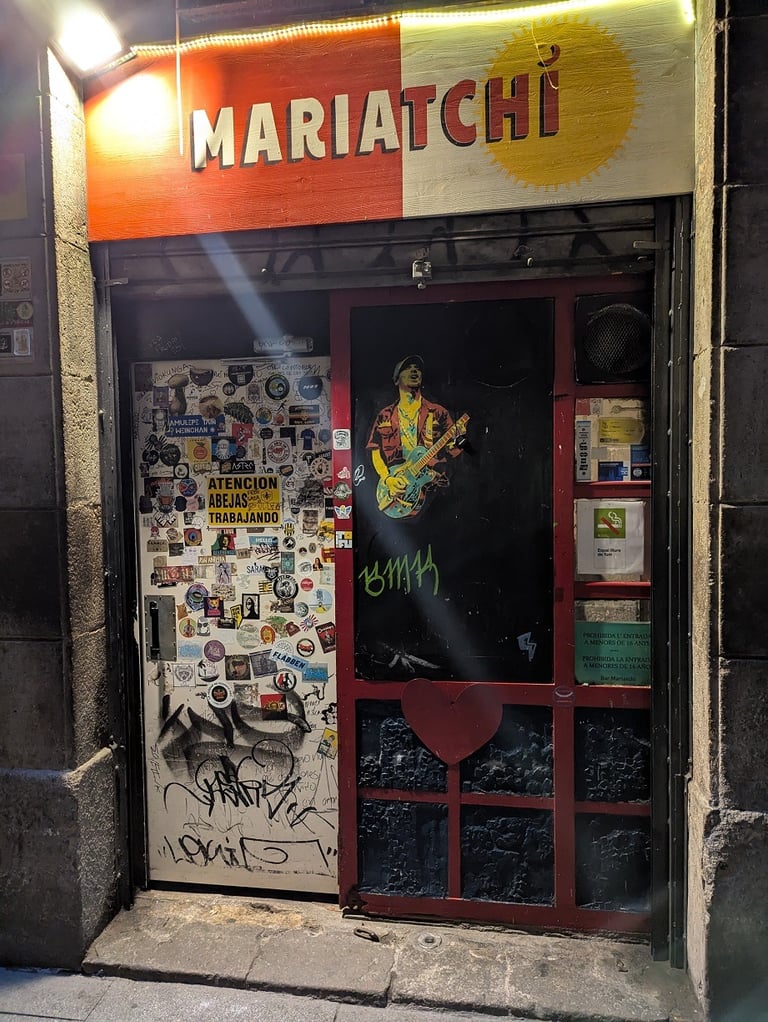

We popped our head into Bar Mariatchi in hopes of seeing one of my favourite musicians - Manu Chao
Day 3: Full day in Barcelona
We had had such an intense day the day before, but had achieved seeing most of the places we planned to see, so the second full day we had in Barcelona was a lot more chilled out. I was dying to fit in a visit to Montserrat. Montserrat is one of the most fascinating places in Catalonia, not only for its monastery and spiritual history but also for its beautiful mountainous and unusual landscape. The Santa Maria de Montserrat Abbey dates back to at least the 11th century, though hermits and small chapels were established on the mountain even earlier. The current Benedictine monastery grew around a miraculous statue of the Virgin Mary, known as La Moreneta (the “Black Madonna”), which became one of Spain’s most revered religious icons. However, the logistics were just a big complicated if we wanted to do much else that day due to the fact that our hotel was in the northern end of Barcelona. If you do have time though, I'd say definitely go! We just unfortunately didn't have enough time. But the fact we didn't make it there, and the fact that we also hadn't had the opportunity to stay any amount of time in Manu Chao's Mariatchi bar makes we want to go back to Barcelona some time again to tick those boxes!
We had a very leisurely start of the day, only really getting ourselves out of the hotel and to the tram station at Selva de Mar station for 10:30am. We rode the tram for a few minutes and then got off at Sicilia station, making the beeline for Gaudi's most impressive and famous work, and Barcelona's biggest landmark - La Sagrada Familia. We both knew it was going to be cool, we had seen it on photographs, and now that we had been to see some of Gaudi's work, like Park Güell, Casa Batlló and Casa Vicens, we knew that photographs don't really do these places justice, because there are so incredibly many intricate little details that are just so curious and/or so stunning, you could spend ages just examining each piece Gaudi has designed. I could show you lots of pictures, but I think the below video gives you a better sense of the scale and the intricacies of La Sagrada Familia a lot better.

By the way - if you want unobstructed views of La Sagrada Familia, sitting on the upper deck of the hop on hop off buses is the way to go! These buses are so big that they block everybody else's view though. We didn't go inside the Sagrada Familia, because you literally have to book tickets to go WEEKS in advance, even in the shoulder season and we just weren't organised enough. Plus, we wouldn't really have fancied standing in those queues either but I am sure it is wonderful on the inside.
After seeing La Sagrada Familia, we trotted up the long diagonal street leading from Sagrada Familia to Recinte Modernista de Sant Pau to have a wee look. The complex was originally built as the Hospital de la Santa Creu i Sant Pau, one of Europe’s most advanced hospitals of its time. Its history goes back to 1401, when several medieval hospitals in Barcelona merged into one: the Hospital de la Santa Creu in the Raval district. By the late 19th century, that medieval hospital was overcrowded and outdated, so a new facility was planned on the edge of the city. The construction of the new hospital was financed largely by banker Pau Gil i Serra, who left funds in his will for a modern hospital to serve the city’s poor. It was designed by Lluís Domènech i Montaner, one of the leading architects of Catalan Modernisme (alongside Gaudí and Puig i Cadafalch). Construction began in 1902 and continued until 1930.
Modernisme at Its Finest The complex is one of the largest ensembles of Modernist architecture in the world, built as a “city within a city”, it consists of 12 main pavilions arranged symmetrically along a central axis, surrounded by gardens, linked by underground tunnels. The layout was revolutionary for the time, designed to promote healing through "light, air and beauty", in contrast to the dark, crowded hospitals of the past. Each pavilion served a different medical specialty and was equipped to maximize ventilation and hygiene. The underground tunnels allowed discreet movement of patients and staff between pavilions. The architecture combines brick, colored tiles (trencadís mosaics), stained glass, and ornamental sculpture. The façades feature religious and allegorical figures symbolising charity, healing and progress. Domènech i Montaner integrated nature motifs; plants, flowers, and animals, as part of the healing environment.
The building is picturesque, but at €18 EUR per person, we found the admission a bit steep, especially as we had already spent fair bit of money on visiting the Gaudi houses and park, even though the Barcelona Card does give people 20% off, taking the price to just over €14 EUR. We just visited the outside. However, if you have the time, money and sightseeing endurance, I am sure it is a really beautiful and interesting site to visit.
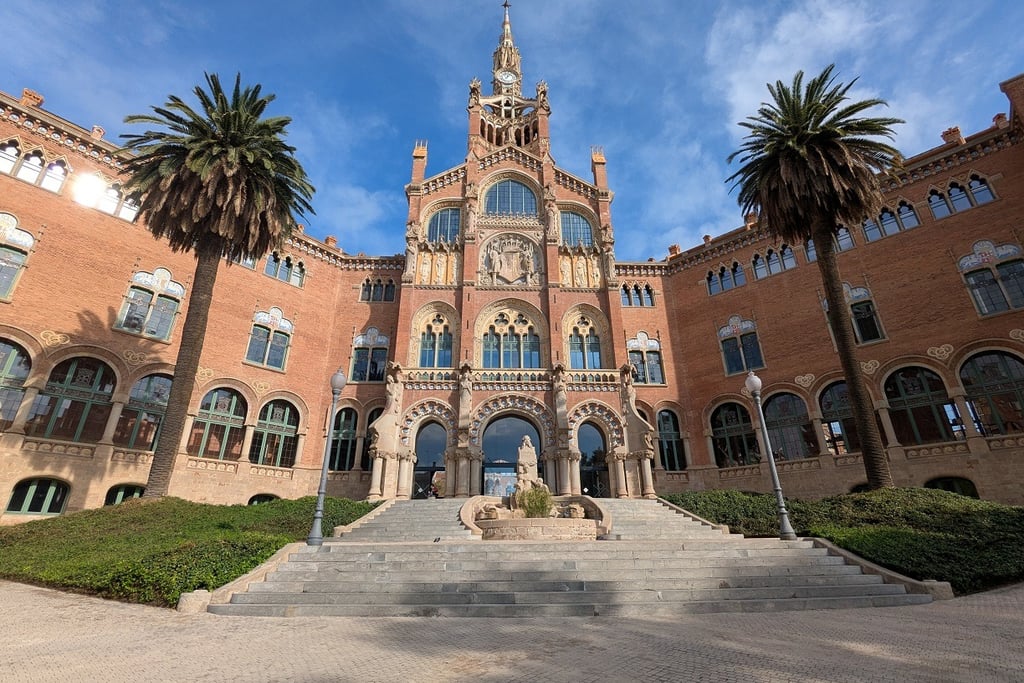

Write your text here...
Barcelona Rooftop Bar
Walking loads around Barcelona is thirsty work, so decided to go for a drink at the rooftop bar that we had originally planned for sunset on our first night but had run out of time. The place is called La Dolce Vitae bar and is at the top of the Majestic Hotel on the main drag on Passeig de Gracia. The views are fantastic and you see far and wide across the city. The prices for drinks are high-ish (about the same as you'd pay on the high street in the UK) but definitely worthwhile for the views. The only issue was the time of day we found ourselves there, as it was midday and the sun was absolutely scorching.

We felt like we were about to boil over in the sun on the roof terrace, so after finishing our drinks we went back to our favourite craftbeer pub for a snack and some drinks - CocoVail near Passeig de Gracia metro station. By the way, this place has the best patatas bravas we have had to date!!.
Aside from seeing the Sagrada Familia, Sant Pau Recinte Modernista, the rooftop bar at The Majestic Hotel and drinking at our favourite craftbeer pub, we also walked around the Gothic quarter and popped into another craftbeer place which is cool as well, called Kælderkold Craft Beer Bar, which is way smaller than CocoVail, but has a very good selection of craftbeers. While in that neck of the woods, we also popped into La Boqueria market, which was a fun experience.
We finished our day relatively early that day - we made our way towards the Peruvian restaurant Cumpanamá near Verdaguer metro and tram station, where we had booked a 4pm table through TheFork app. Verdaguer was kind of like a halfway house for us between the town centre and where our hotel is located. By the time lunch was done we just headed back to the hotel to chill for a bit, then back to our local tapas restaurant Sukhu 111 for some nightcap wine and a wee late night snack before heading to bed.
We had to wake up sharp-ish the next morning to get ourselves ready to fly home.
Is there anything we would have done differently?
Below are a few of my observations after visiting Barcelona and the things I wish we had done differently.
Stayed longer than 2 full days
I am generally pretty good at planning packed itineraries that work, but sometimes things get in the way. One thing I sort of wish we had done is to have stayed maybe one more night at least, cause I really wanted to see Montserrat. Not so much for the monastery but the cable cars and the UNBELIEVABLE nature around it. But there was absolutely no chance we were fitting that into the 2.5 day itinerary.
More time to eat more food
I also would have wanted to stay longer just to eat more tasty stuff! Spain has incredible food and Barcelona has soooo much exciting food from Latin America, I was sad I only got the chance to go to one Chilean restaurant and only once.
Visited more street food markets
We poked our head into La Boqueria, which is by and large just a touristy place, but there are meant to be some real good, more local markets in other parts of Barcelona. Had we had time, we'd have gone in search of some others that are more "off the beaten track".
Different place to stay
I think I probably would also have stayed somewhere else than in the Melia in Sant Marti, because there's just literally nothing there. You struggle to find food, there are so few restaurants and zero bars aside from the hotel bar, unless you fancy a decent walk in the dark. But it was significantly cheaper than many other options, and accommodation in Barcelona is SO expensive! So I guess.... swings and roundabouts.
Cash and ATMs
Another thing I would have done if I had known, is to take a lot more cash with us from home. The ATMs in Spain are an absolute utter ripoff. You have to pay anywhere between €5 EUR and €9 EUR for the "service" of having the ATM spit you money. Hecking hell. So yeah - definitely make sure you carry the cash you think you'll need!
Would have used our hotel's rooftop pool
We were so busy because we had such a short time, and our hotel was so far out of the way that we never had the opportunity to enjoy lounging around the rooftop at our hotel. Lots of hotels have rooftop pools and it would have been nice to have time to chill.
Packed less in on the first full day
We were absolutely shattered after the first full day of sightseeing, but I was worried we would possibly miss some of the important sights if we ran out of time. We would have had an even better time if we had spread the sights out a bit more.
Follow us on Social Media for travel updates and top tips!
© 2025. All rights reserved.
Find out about super-cheap flights and flight sales as soon as they happen from your home airport. Try 30 days for £1 GBP with 14 day money-back guarantee and cancel any time.
Click here for more information.


